The city of Venice is made up of 118 islands, 400 bridges and 150 canals. With all that said, you might be surprised to learn that it’s actually a pretty walkable city. The entire island can be explored in one, albeit long, day. In this way, no one neighbourhood is ever too far away from another and as such, there is a real feeling of connection between all the different parts of the island. A strength and unity that this city shares which I think is hard to find in other places around the world who have the luxury of continuous expansion. Venice had only so much land before they spilled out into the ocean, so every brick, every stone and every bridge needed to be made with thoughtful consideration and made to feel like it was a cohesive part of this great puzzle.

Day One – The Highlights
St. Mark’s Square
The best place to start your tour is standing in the centre of the Piazza San Marco or St. Mark’s Square. Arrive here as early as you can bear. There is something truly magical about being here as the sun rises on the square. You’ll see the beautiful rose-gold sunlight begin to kiss the cobblestone and bricks around you. The sun seems to bring the square to life as cafe owners begin taking out their chairs and pigeons flock around gawking tourists (but don’t feed them, this is now illegal in Venice!)
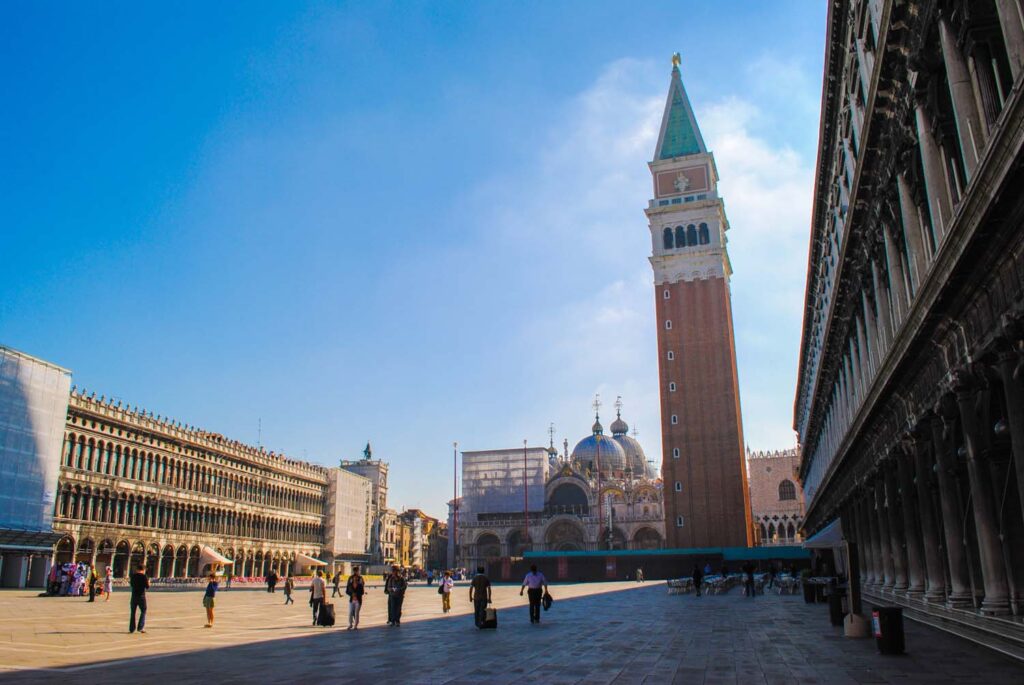
Standing in the centre of the square, in front of the Basilica, you can turn around 360 degrees and see one spectacular scene on top of another. In this one small area, you’ll find the St Mark’s Basilica, the great Campanile (Belltower), the Procuratie, the Piazzetta, Doge’s Palace, Bridge of Sighs and Torre dell’ Orologio. There is rarely a time when you’ll visit the square when they aren’t some form of construction or renovation going on. With all these historic sights in one place, there is bound to be something falling apart and needing repair. Try to look past that and don’t like it ruin your experience.
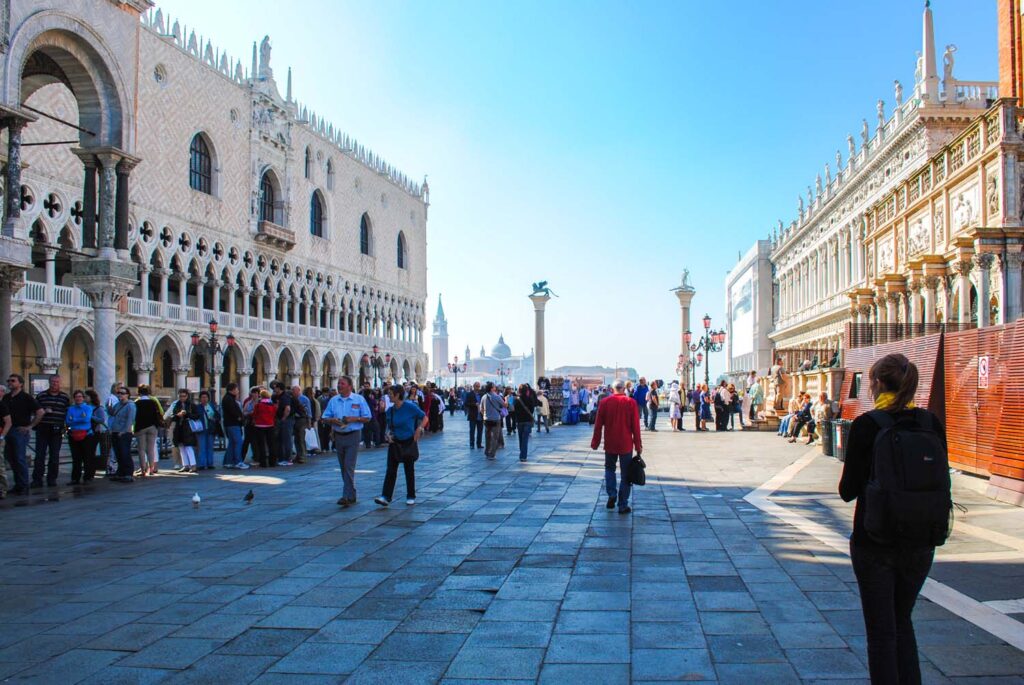
Saint Mark
The square is named after the patron saint of Venice, Saint Mark. In 828, a relic of St. Mark was stolen from Alexandria and brought back to Venice by La Serenissima‘s great naval fleet. The Venetian Doge, awed by the acquisition of this precious relic, adopted Saint Mark as the new patron of Venice (whose honour had previously been given to Saint Theodore).
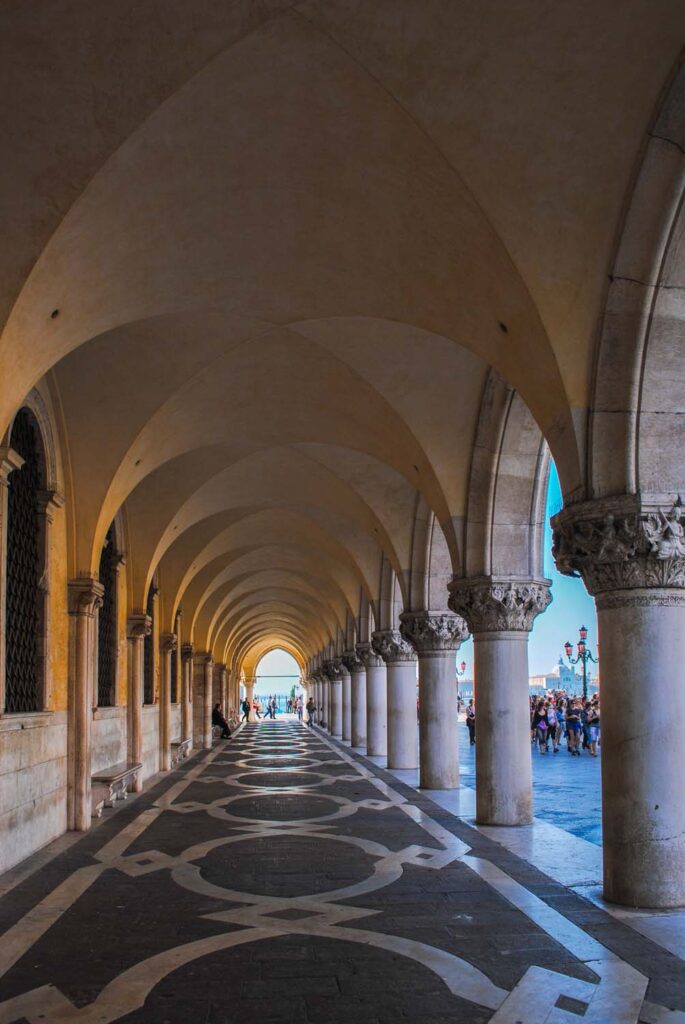
A city with a saintly relic immediately rose in power and prestige. Relics were the first tourist attraction of the medieval world. Pilgrims would come from all over the world to pray at the churches who preserved these relics. Pilgrims, much as tourists today, needed food and shelter and therefore brought lots of money into the city.
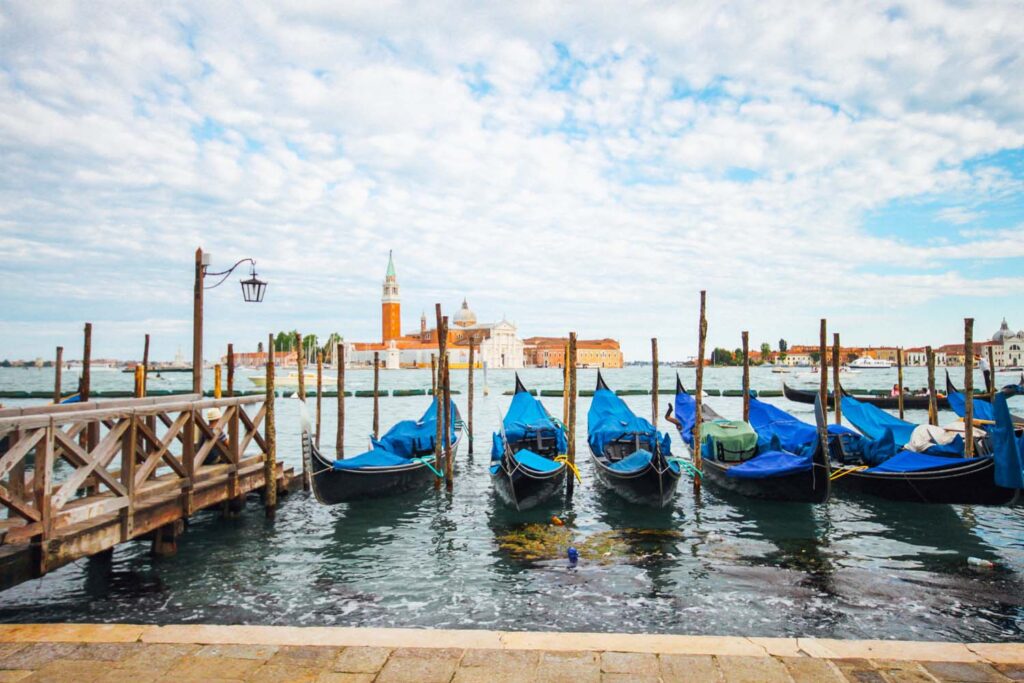
Piazza San Marco
A grand church to house the precious artifact began to be built in 836. The church and the nearby Doge’s palace were, even back then, the highlight of the city for visitors. And a great square was needed to further showcase the opulence the Doge wanted to project. In 1172 orchards were demolished surrounding this area and the Piazza San Marco was built. It’s been rumoured that upon visiting St. Mark’s square for the first time, Napoleon himself degreed that it was, “the drawing room of Europe“.
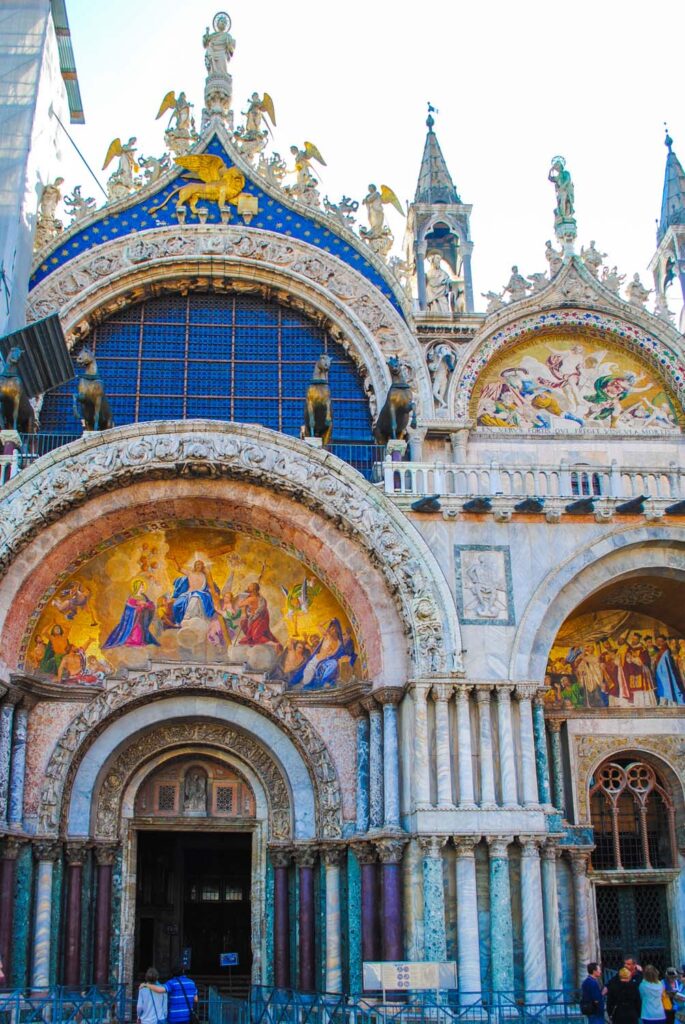
The Procuratie
The simplistic and yet elegant buildings along the north and south sides of the square are called the Procuratie. The Procuratie is most identifiable by its stunning arcade that wraps around this side of the square. The arcade features Byzantine arches, which are distinct for their tall and narrow structure.
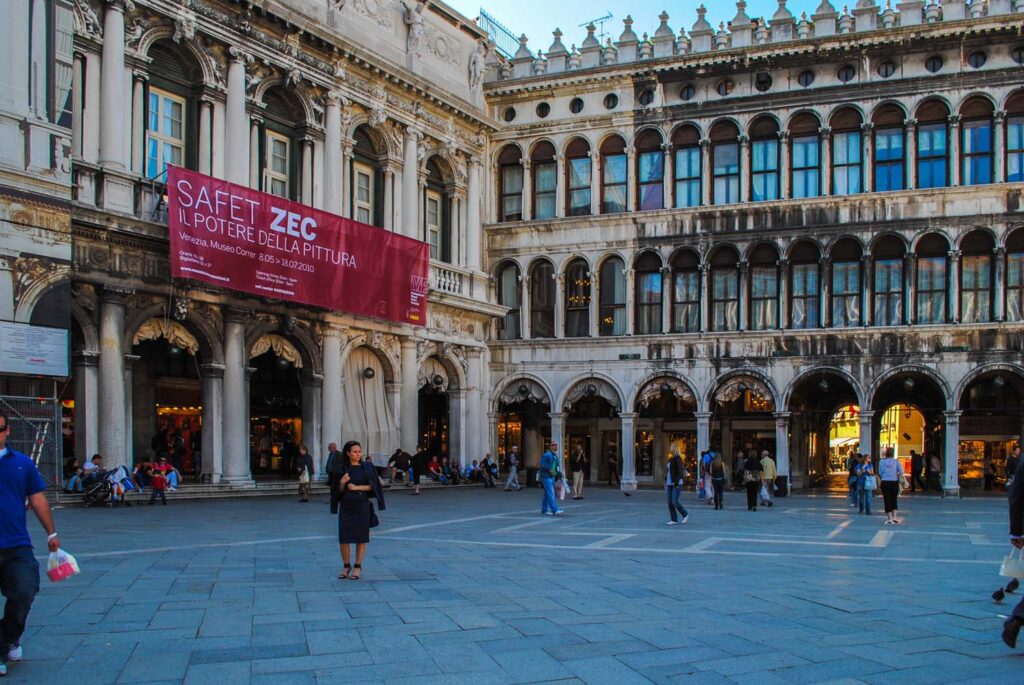
The Procuratie buildings are actually three connected structures that once served as the offices of the Venetian Republic, also called La Serenissima. Today they house the Correr Museum, the Museum of the Risorgimento, and the Archeological Museum. Each one of these is an incredible place to visit but the Correr Museum is my favourite with their collection of art detailing the histories of the city of Venice.
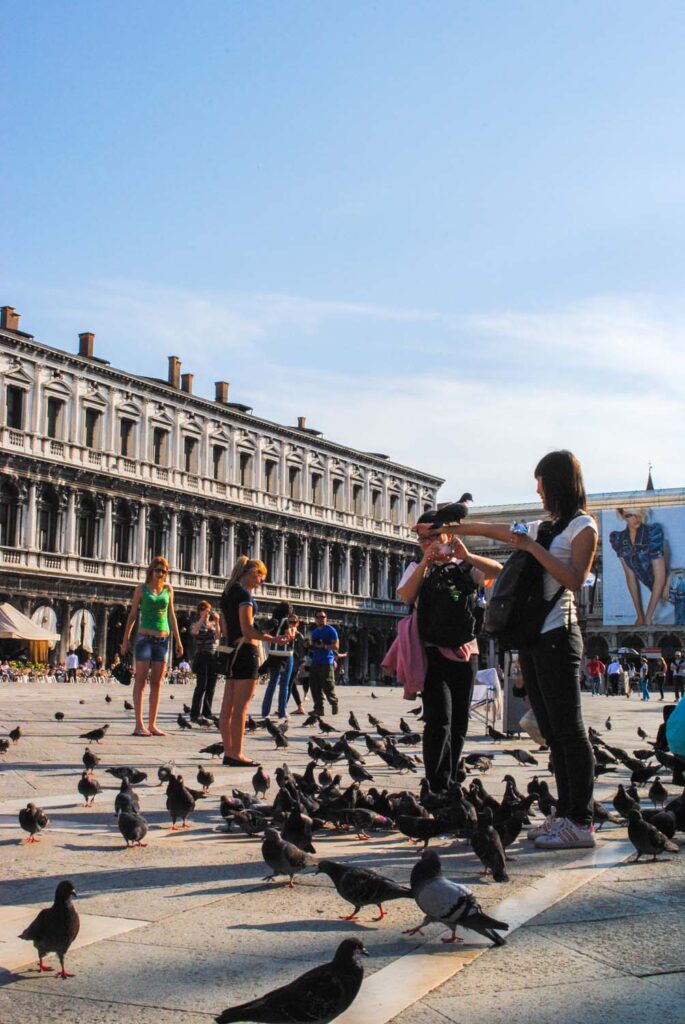
The Lion of Venice
Throughout St. Mark’s square you’ll see various Lions of Venice, adorning doorways, columns and facades. The Lion of Venice is usually seen with his paw upon a bible as he is not just any lion, but St. Mark’s Lion. St. Mark was often referred to as a lion since he would preach the word of the lord so powerfully it almost seemed like a roar. Legend tells that St. Mark was travelling through Europe when he arrived in Venice and an angel spoke to him and told him that this place would be where his body would come to rest for eternity. His remains were originally interred in Alexandra but moved to Venice where the church was built to honour them.
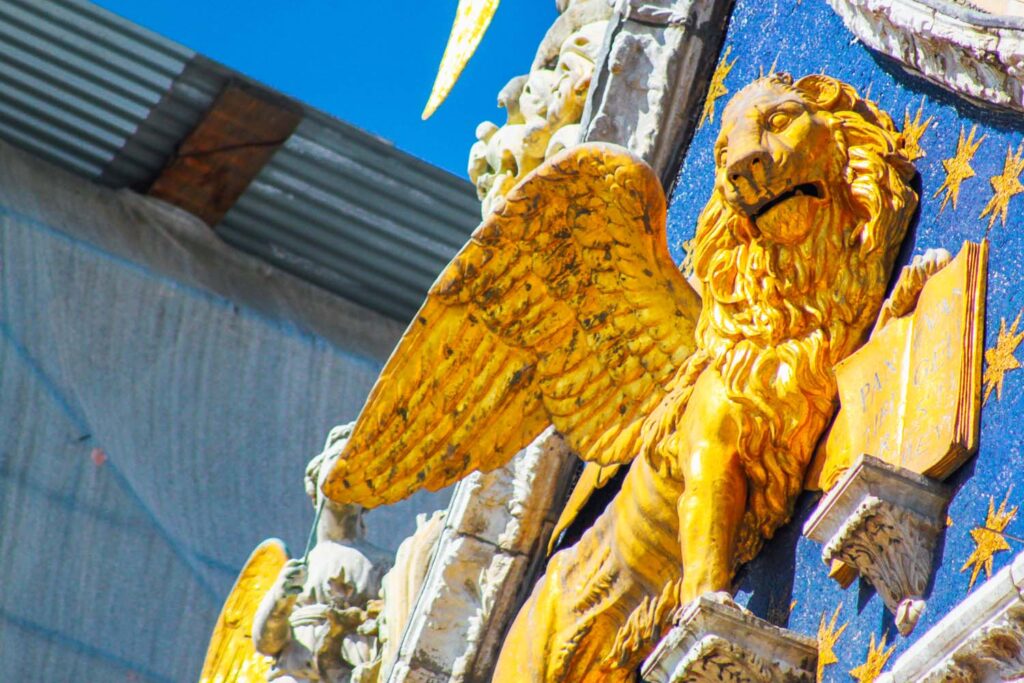
Caffe Florian
Now housed inside one of the old Procuratie buildings is perhaps the most sumptuous cafes in Venice, or perhaps Europe itself. Although this cafe is by no means cheap, it’s a splurge that I think is worth it for the incredible interiors and history to be found within. The Caffe Florian was founded in 1720 and has served patrons like Charles Dickens and Lord Byron. There is a 6 euro cover charge to even enter the cafe, but along with getting to enjoy the lavish interiors, you’ll also be treated to a live orchestra which plays throughout the cafe. Palacial red velvet couches and chairs are spread out across the huge cafe, dotted throughout various antechambers. Each room is covered in ornate paintings, large Murano glass mirrors, gold foiled frames and intricate painting plastered to the ceiling.
To save a bit of money here, go right to the bar and order your food or drinks there. Although you won’t get a seat, the bar menu is vastly cheaper than the table service. An espresso at the bar will run you €5 but again, you’re here for the atmosphere. If you’d rather save your coin you can give this a miss for sure. Instead grab a coffee on your way in towards St. Mark’s square from any local cafe, to enjoy while you peruse the sights.
The Campanile
Standing guard in the centre of the square is the 323ft tall Campanile or Belltower. The low-level buildings throughout Venice are in stark contrast to the towering Campanile. Its little head pokes out at you no matter where you seem to end up in Venice. While the original tower was built in 1514, the current one is a reconstruction from 1912 after it’s collapse in 1902. It’s an incredible thing to imagine that such a tall structure could survive for so long-standing atop the shifting waters. But it wasn’t water which proved to be the biggest enemy of the tower, it was lighting. Lightning struck the tower multiple times over the years causing enormous fires and severe internal damage to the structure.
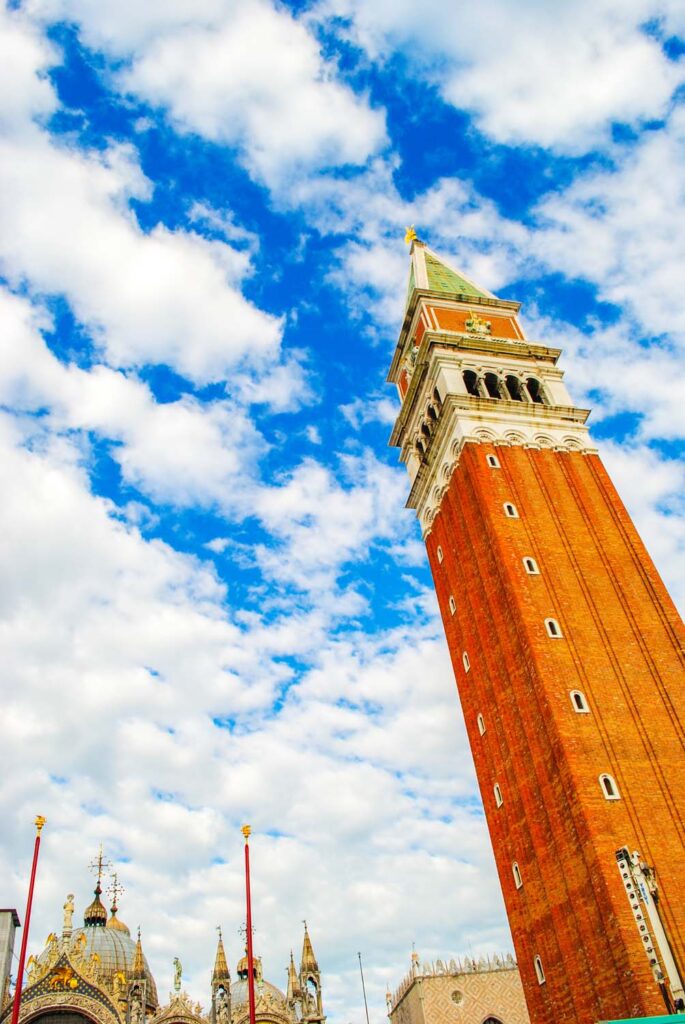
The tall base of the tower is designed with a fluted shaft that reaches up towards the belfry. Along one corner, one each side of the tower, are stacked arched windows looking out over the square. Inside the belfry are five large bells. Each one was used to call the people of Venice to attention. The bells have their own distinctive name and special significance. The Renghiera bell announced executions; the Mezza Terza would declare that a session of the Senate was taking place; the Nona sounded the midday hour; the Trottiera was used to assemble the Maggiore Consiglio and the Marangona, the largest of the bells, rang to mark the beginning and end of the working day.
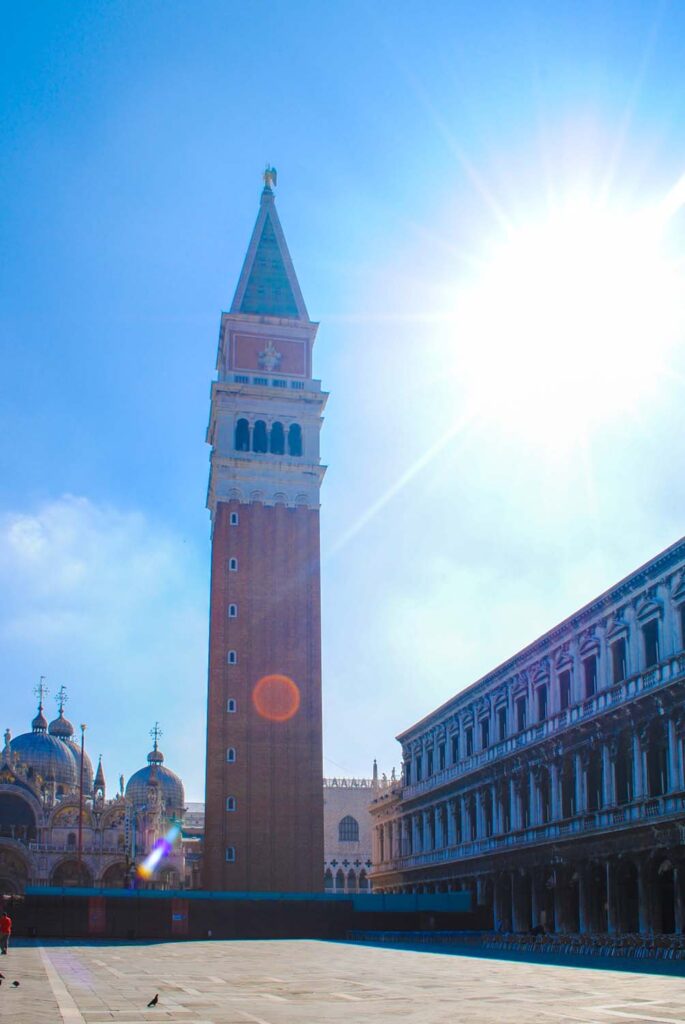
The Tower’s Crown
Above the arches of the belfry is another level of brickwork decorated with various sculptures on either side. On one side you’ll see the Lion of St. Mark and on the other the female representation of Venice, in the shape of the lady Justice. The golden weathervane which crowns the tower is the angel Gabriel, reaching out towards the citizens below.
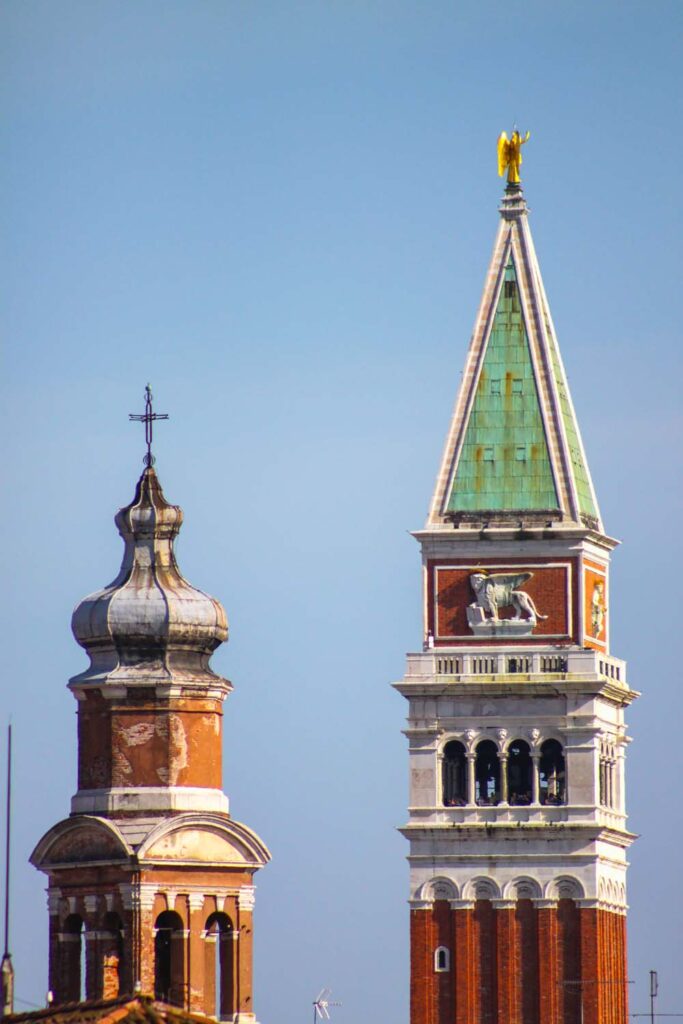
Torre Dell’Orologio
Turn to the north-east corner of the square, and look up at the bright blue and gold details decorating the Torre Dell’Orologio. The morning light, the sunlight simply glints off the golden dial. The clock was built in the 15th century when mechanical clocks were a symbol of wealth and power. The clock faces out towards the water so that any foreign ships would be able to see it from the canals as they past through.

Atop the tower containing the clock, you can see two small bronze figures who carry large hammers in their hand which move upon the hour to strike the bell. One of the figures is a young man and the other an old man to symbolize the passage of time. Once more we see the image of the Lion of Venice above the clock, set against a blue sky of golden stars. Below the lion is the figure of the Virgin Mary with the baby Jesus wrapped in her arms. On either side of her are two blue panels with the time represented in roman numerals on the left and in Arabic numerals on the right, as was traditional at the time when the Byzantine influences were ripe throughout Italy.
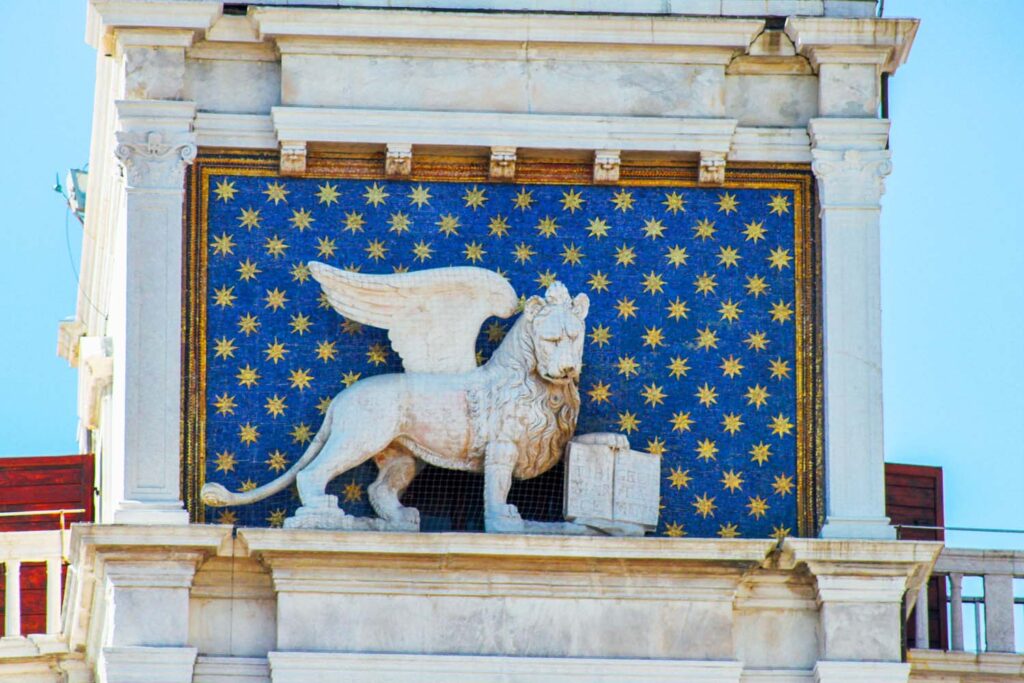
The Zodiac Symbols on the Clock
The most impressive feature of the clock is the blue and gold engraved clock face with fantastically detailed signs of the zodiac encircling it. The large dial on the clock is set with the huge face of the sun. The dial, emblazed with the image of the sun, revolves around the zodiac signs and rather than showing the time, it marks the date. In the centre is a small gold orb representing the sun and below it, a smaller orb representing the phases of the moon.
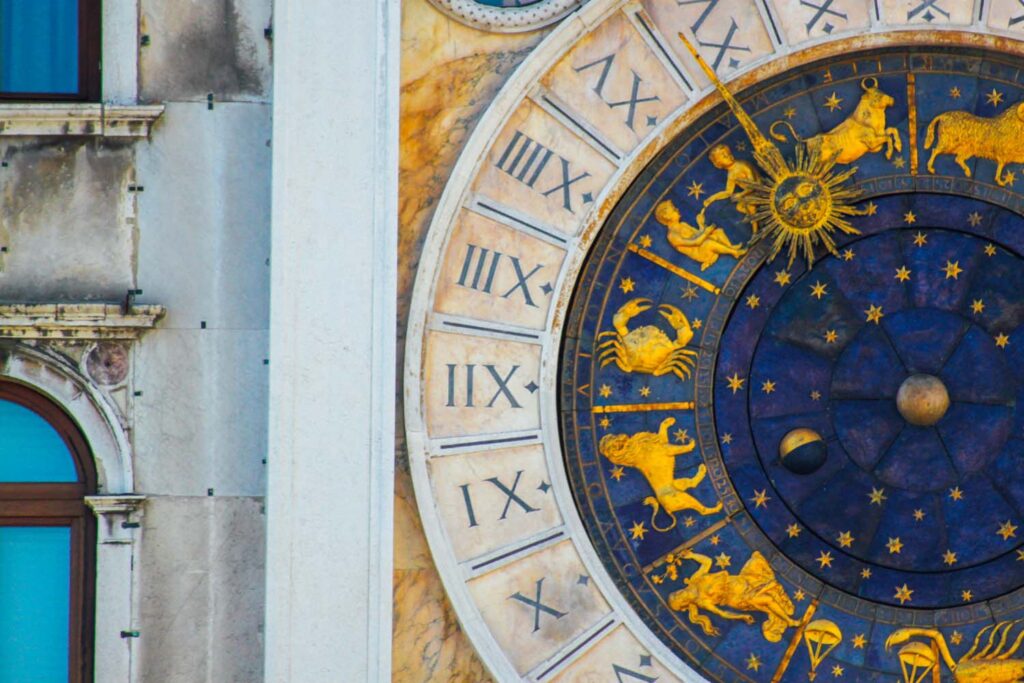
St Mark’s Basilica
St. Mark’s Basilica is famously one of the most precious Byzantine treasures of the time. Within it, preserved by time, are so many aspects of history, art culture and faith. The most notable element of the design of the church are the powerful domes that are set against the sky. The bulb-shaped domes with their finials lanterns give the church that middle eastern appearance and character which defined the Byzantine period.
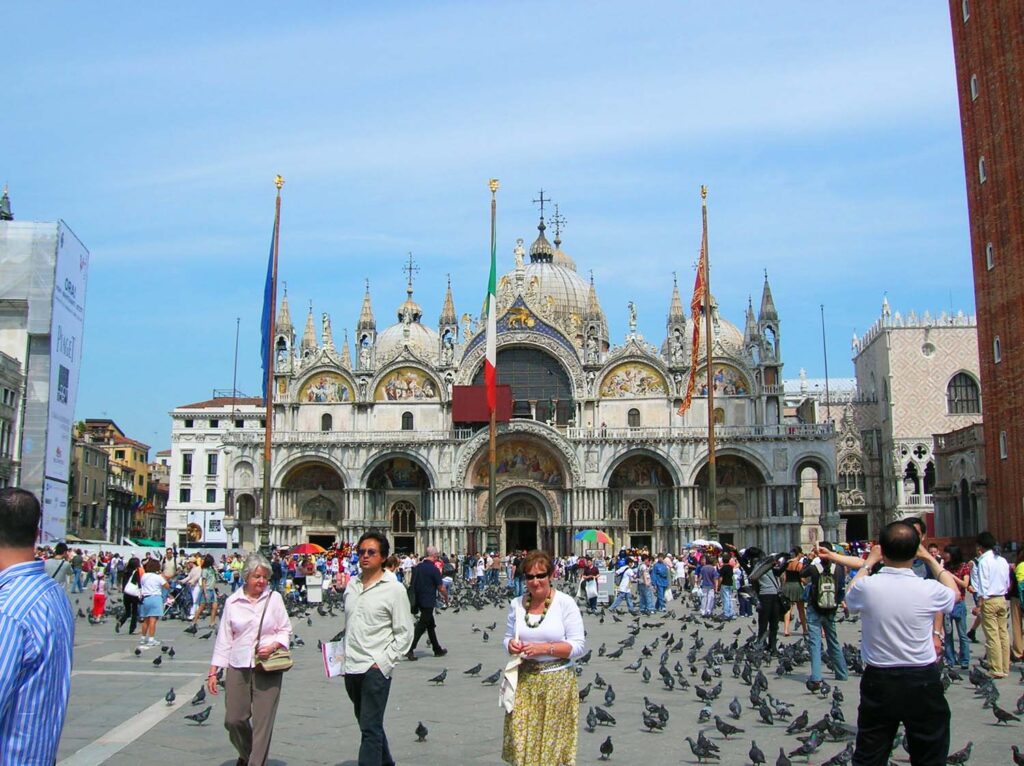
The exterior of St. Mark’s Basilica can be studied by its three distinctive areas; the lower level, upper level and the domes. The lower level mosaics are all scenes from the life of Saint Mark, for whom the church derives its name. In the central arch where the enormous doorway is located there is the largest mosaic which depicts the Last Judgment. The original mosaic would have been made in the 13th century but this current incarnation from the 19th-century. The portals which lead into the church are stacked with various colours of marble, creating a foreshortening perspective effect. Like you are being pulled into the church.
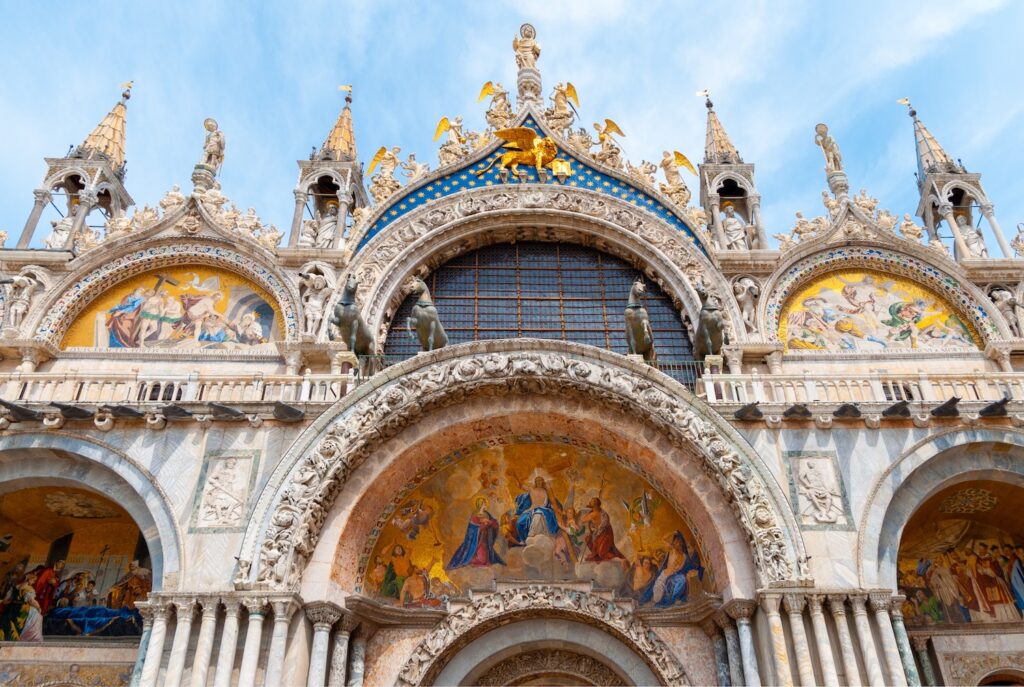
Mosaics of St. Mark’s Basilica
On either side of the central portal, the mosaics each depict the life of St. Mark. The first one on the left is the only one on the façade still surviving from the 13th century. The lunettes above the first floor depict the life of Christ. The lower level features dozens of marble columns. These rich columns are decorated in sumptuous vegetal motifs.
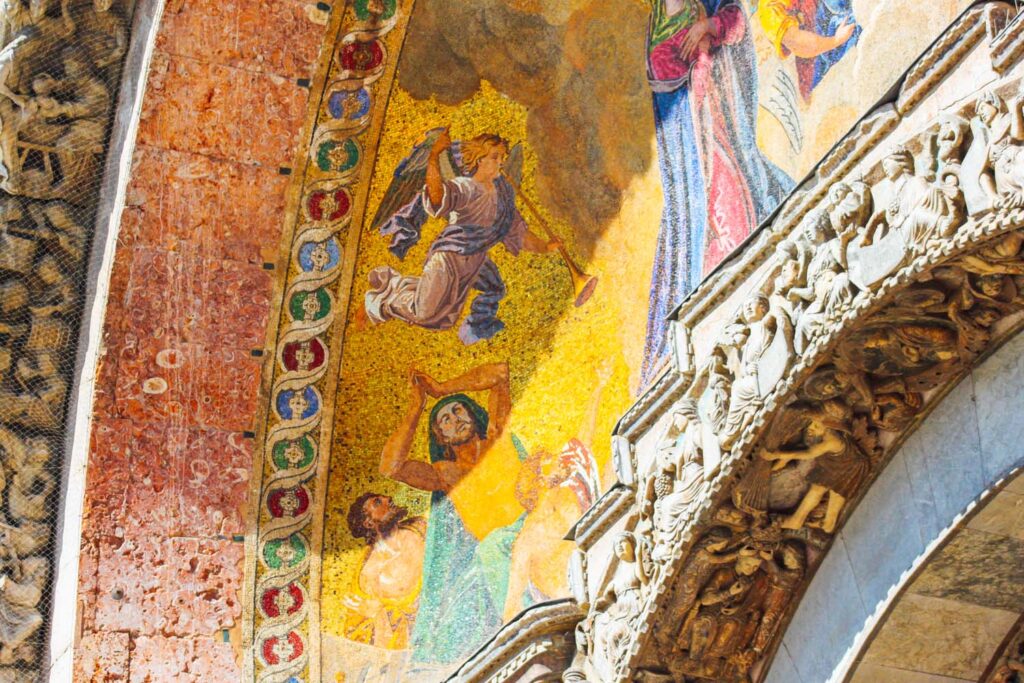
The Bronze Horses
The upper-level balcony, above the main entrance, also features four bronze horses. There are the Horses of Saint Mark-Lysippos and were stolen from Constantinople in 1252. The ones outside the church today are actually replicas of the original horses, as the originals were suffering terribly from the elements. They were brought inside the church museum in order to preserve them for years to come. The original bronze horses date all the way back to classical antiquity. It is rumoured that perhaps they once were positioned pulling an emperors chariot atop the Arch of Trajan in Rome. The Horses were one of the many trophies collected during the Crusades.
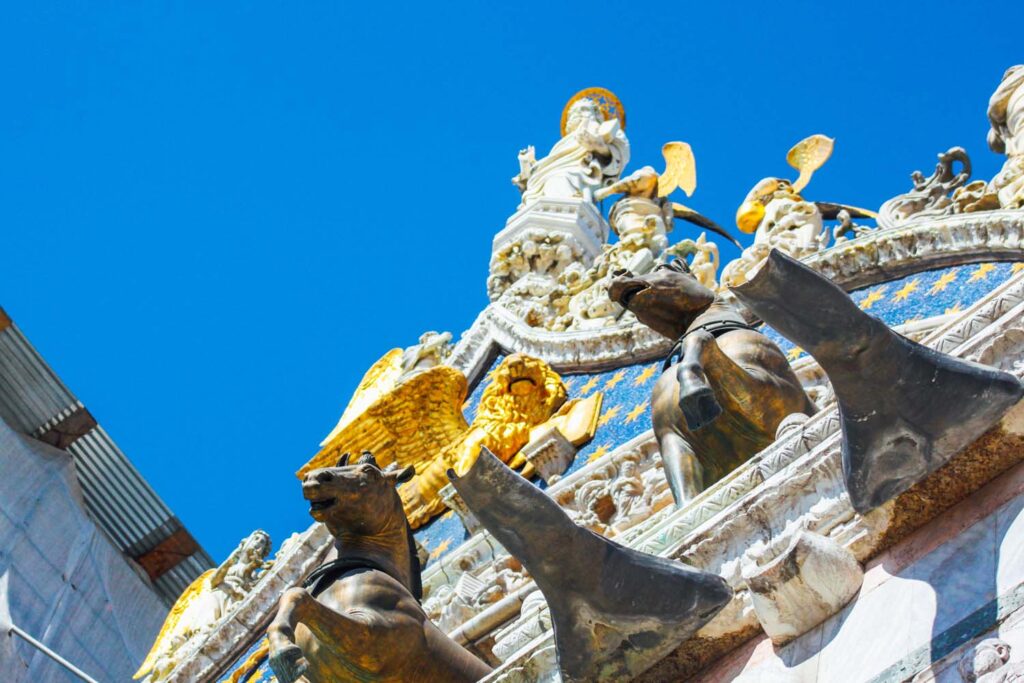
Above the horses, the ogee arch is decorated with blue glass and golden stars. In fro of this starry sky is the gilded winged lion, the symbol of Venice. Above the great lion, standing brightly against the blue sky, are Saint Mark and his six angels.
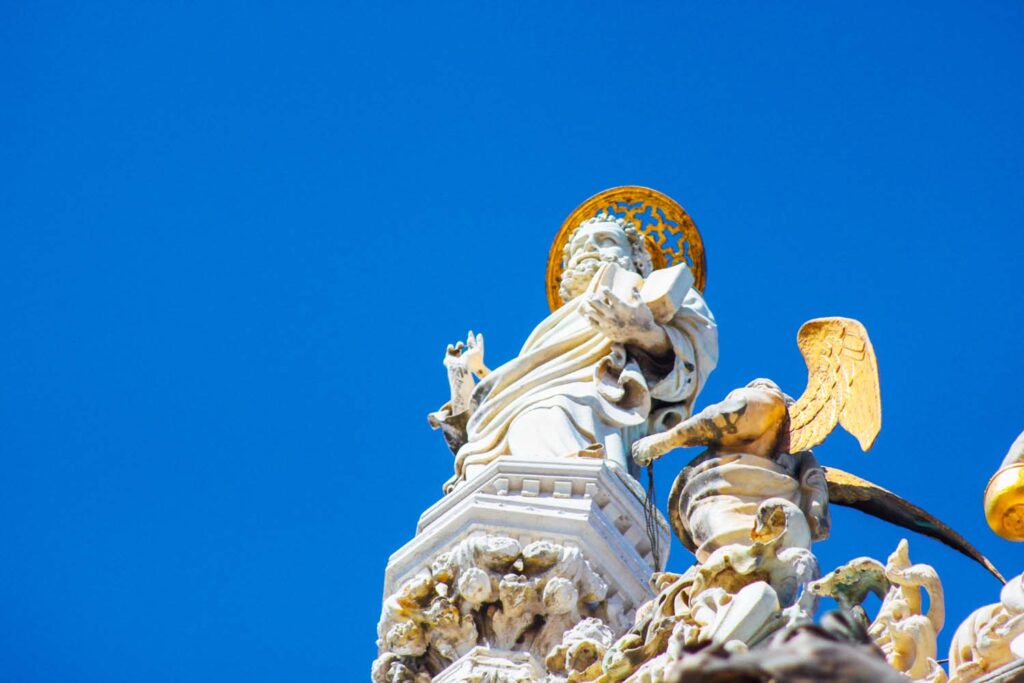
Entering St. Mark’s Basilica
If you are interested in going inside the Basilica, be warned the queue can get very long. But if you want to save yourself a bit of time you can book a timed entry ticket online that only costs €6.00. Well worth it, in my opinion, to be sure you are the first one in the door, leaving the rest of your day completely open.
If you don’t buy your ticket in advance, you will have to line up. The wait time is, on average, about 45 minutes but the earlier you arrive in the morning, the less of a line you’ll run into. When we arrived, early in the day, the line moved swiftly and we barely had to wait at all. But of course, this depends on the time of year you visit.
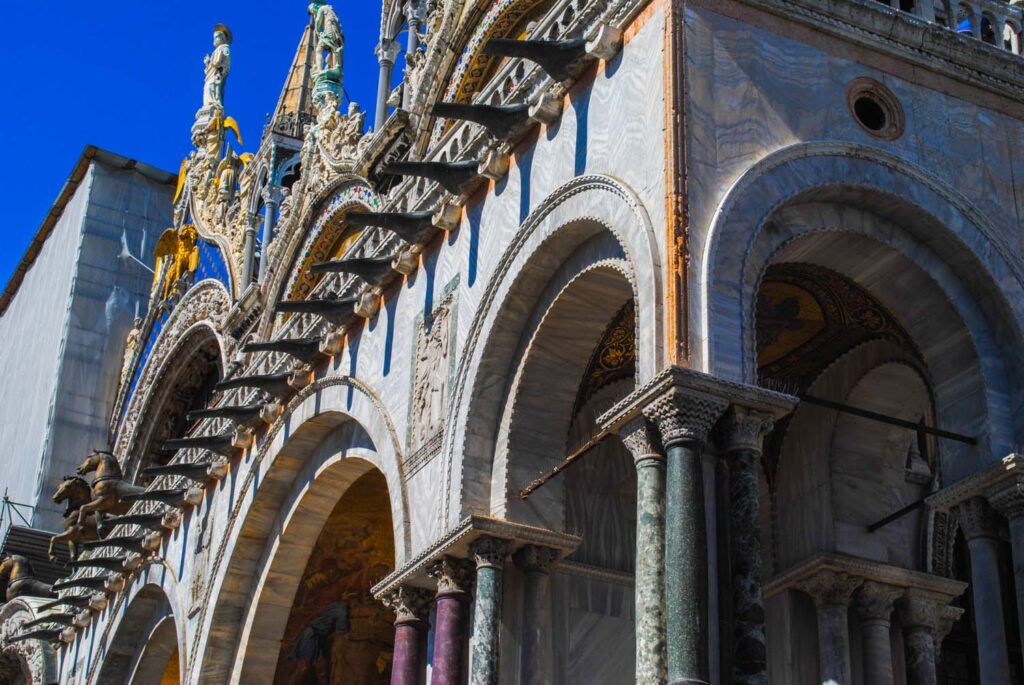
Interior Mosaics
Upon entering the church the first thing you’ll notice is the overwhelming amount of golden mosaics covering the floor, all the way up to the domed ceiling. There are over 85,000 square feet of mosaics in St. Mark’s Basilica. The light reflects off the surface of the glass and depending on the time of the day, the light changes the effect and the appearance of the interior. So depending on when you visit you might get a different experience from someone else. So much gold was used in its construction of the church that the residents of Venice would call it the Chizea d’Oro or, the Gold Church.
Because the Basilica was built during the Byzantine age, and architectural methods weren’t as advanced as they are now, you’ll notice large thick walls, hundreds of columns and the heavy use of marble. They needed only the strongest of materials to help keep the multi-domed ceiling standing.
Inside the church are the treasures of the fourth crusade on the holy land. During the 4th-century crusade, Venice deemed itself the holiest place on earth. And therefore all the treasures the crusading armies found were brought to Venice. One such treasure is the Pala d’Oro. The Pala d’Oro is decorated with 1,300 pearls, 300 emeralds, 300 sapphires, 400 garnets, 100 amethysts, plus rubies and topazes. A glittering masterpiece.
Porta Della Carta
Coming back out of the church, into St Mark’s square, be sure to take a moment to study the Porta della Carta on the side of the church. In 1442 this was the ceremonial entrance to the church was built to connect the church to the Doge’s Palace. The doorway is dripping in gothic ornamentation, with two tall, thin pinnacles flanking either side of the statue of the Doge Francesco Foscari. The Doge is seen kneeling before the Lion of Saint Mark. Below each pinnacle is are statues of cardinal virtues.
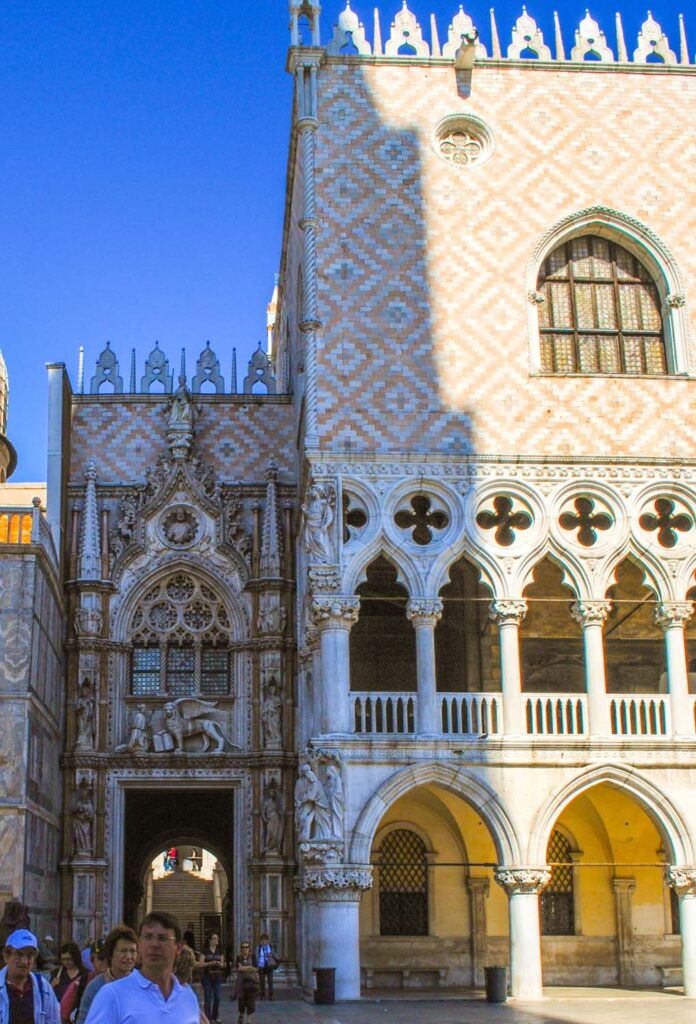
Doge’s Palace
A Venetian Doge is something that many of you may not have heard of before. A Doge is pretty much like an English Duke, they served as the leader of the Republic of Venice from 726 to 1797. The Doge would rule over Venice from his seat of power inside the incredible Doge’s Palace. Today the building serves a public museum.
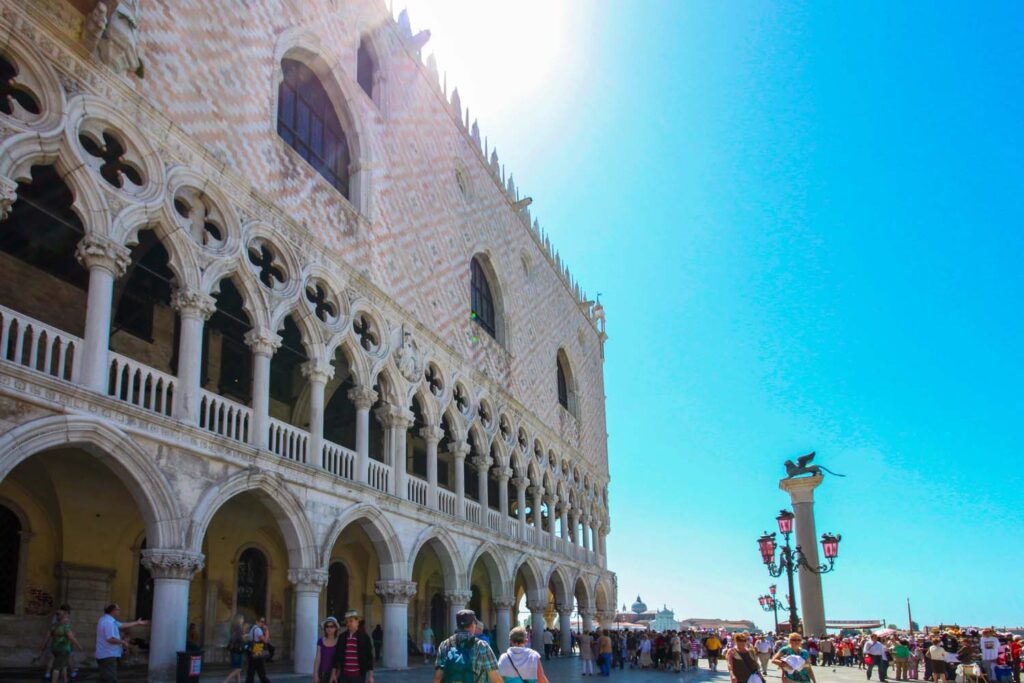
The building itself is a wonder to behold. Despite the enormity of the upper structure, it looks almost weightless as it is supported by the delicate pink Verona marble columns. The columns are decorated with a lacy pattern, making them look even more fragile. The top of the building is adorned with spiked merlons and looks like frosted meringue atop a cake.
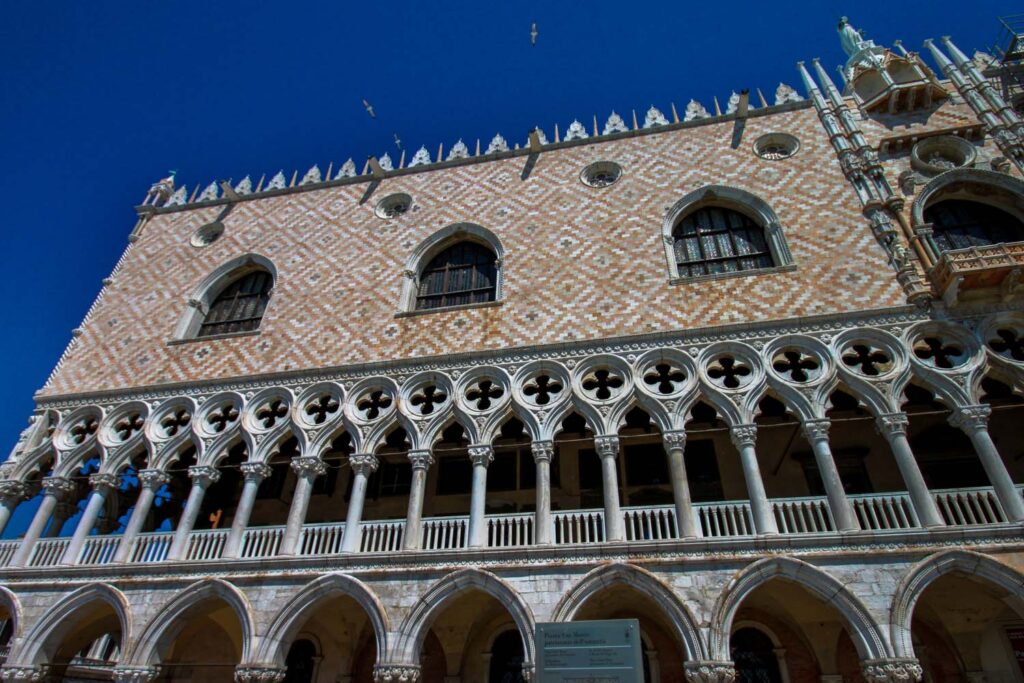
Walk through the arcade and study the individual capitals of the columns on the right side.
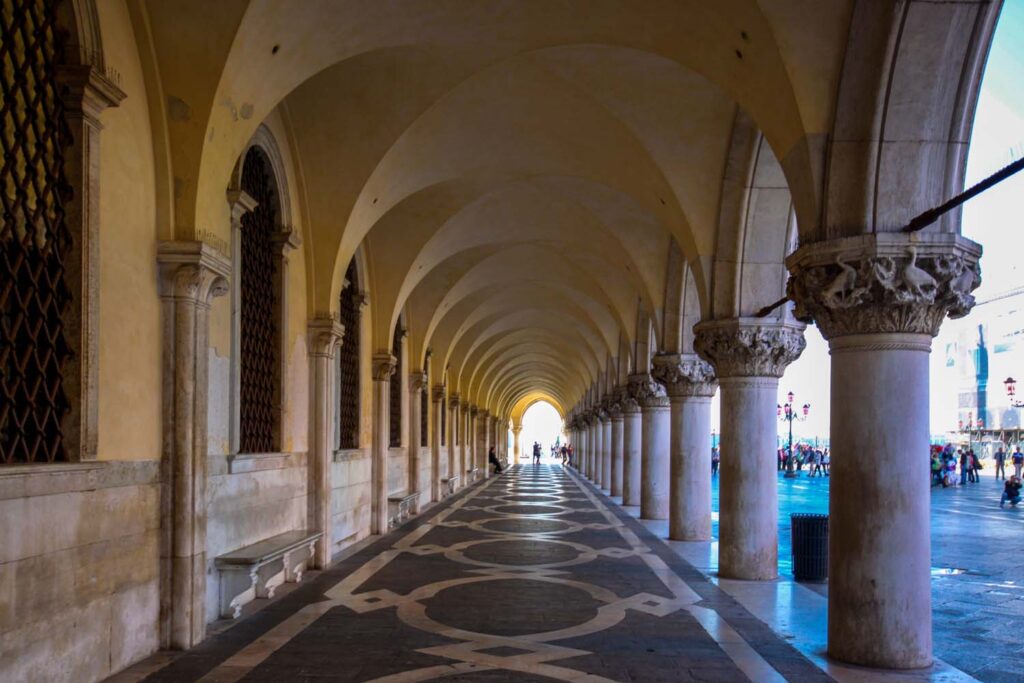
Piazzetta
Past the Basilica, walking south towards the water, you can find the Piazzetta. The Piazzetta is the smaller square to the south. In the middle of the square are two large two columns, made in red marble. Between these two columns is where death sentences were announced during the medieval ages.
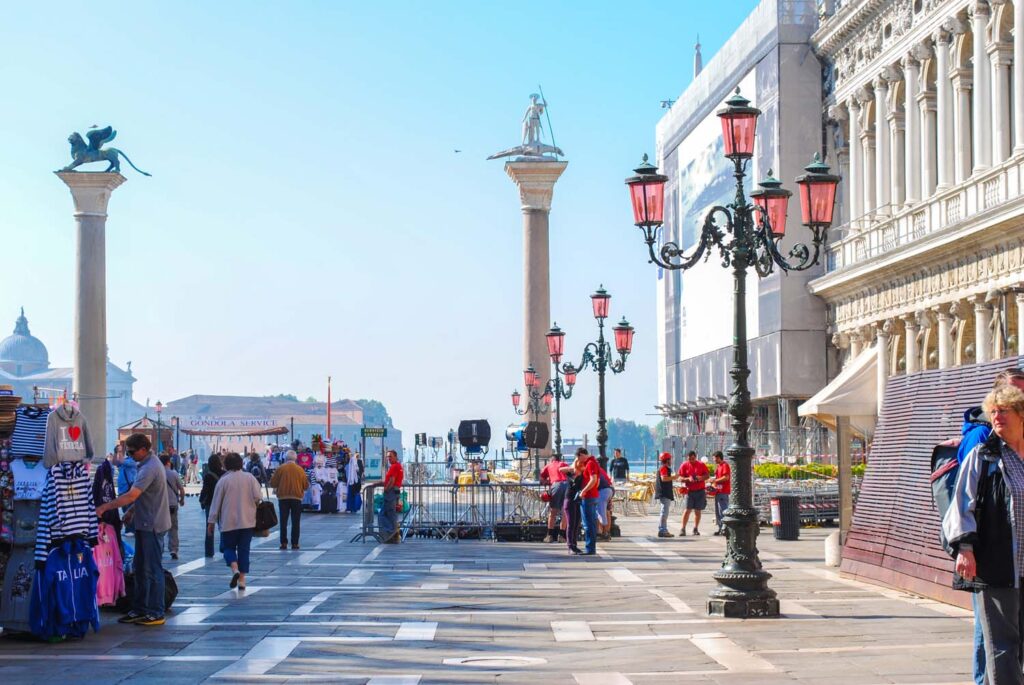
At the top of the columns are two statues, each depicting one of the patron saints of Venice; St Mark and St Theodore, on the left and right respectively if you’re facing the water. St. Mark is depicted as the winged lion of Venice and St. Theodore can be seen standing atop, of all things, a crocodile. In his hand, he also holds a spear which we can assume he used to slay the giant crocodile. Saint Theodore is more commonly known for slaying a dragon, not a crocodile, but perhaps the Venetians artists of the time who made this carving had little knowledge of what a real dragon looked like, so instead, they simply carved the next best thing, a crocodile.
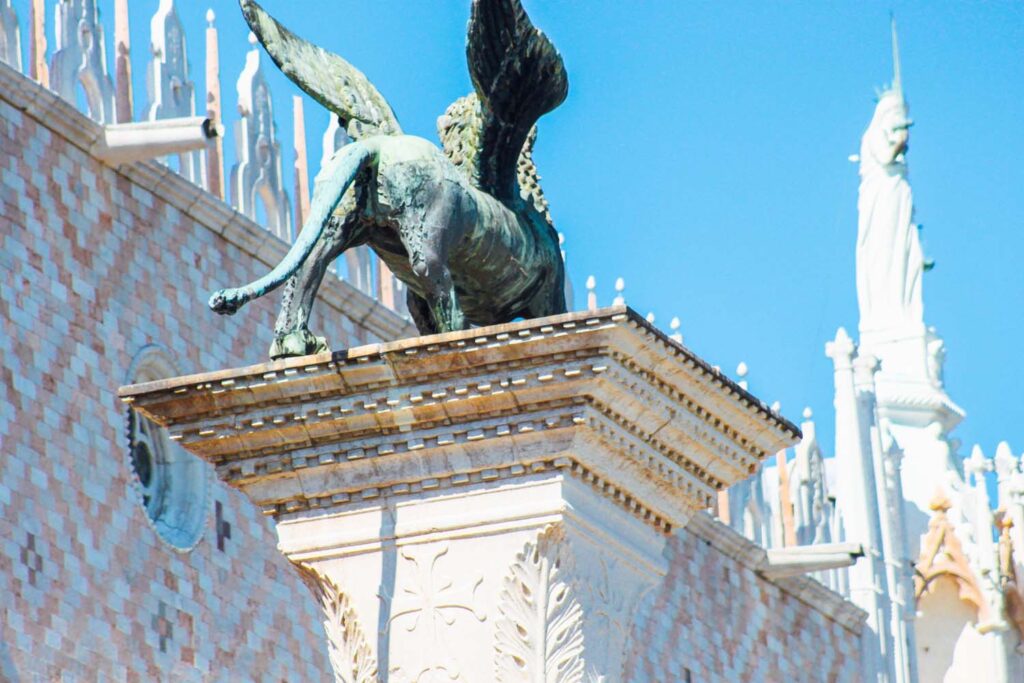
The Bridge of Sighs
Walk around the Doge’s Palace until you turn to face the Bridge of Sighs. The bridge of sighs created to join the interrogation rooms of the Doge’s Palace to the prison across the canal. If you were found guilty by the Serenissima you were set to the prison, but upon crossing the bridge, were allowed to look out at Venice one last time. Two small, square windows on the bridge allowed prisoners this one moment of reflection, before facing their possible lifetime of imprisonment. The bridge’s windows are covered in a tightly knit wrought iron bars, so no one could escape.
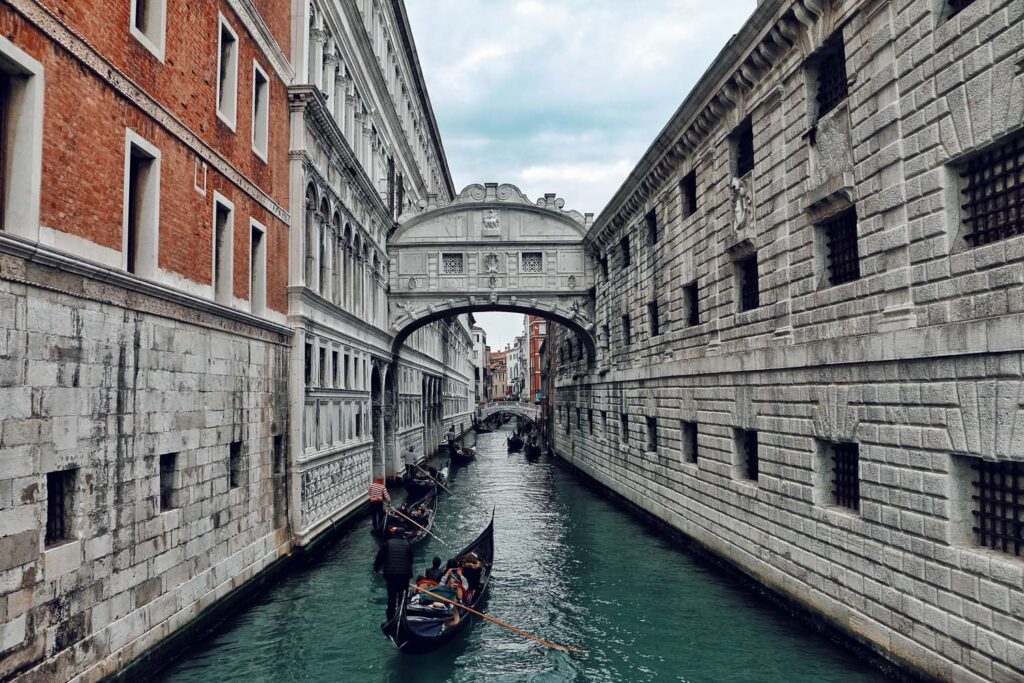
Day Two – Exploring the Hidden Canals
Palazzo Contarini del Bovolo
Continue heading north until you reach the Palazzo Contarini del Bovolo. This small palazzo has become an iconic viewpoint in Venice. The palazzo’s incredible, honeycomb-like spiral staircase, with a fantastic balcony at the top, provides one of the most amazing views across the city, and over St. Mark’s square. The staircase is called the “Scala Contarini del Bovolo” or “or the snail”.
Built in the 15th century for the wealthy Contarini family, the house became instantly notable for its unique outer staircase. In 1952 Orson Welles also fell in love with the house and even featured it in his film adaptation of Shakespeare’s Othello. The Palazzo was closed for many years but in 2016 it opened up its doors to the public. For three euros you can climb the stairs to the top and get a snap of the great landscape.
Explore the Side Canals
Make your way through this small island, heading north and slightly eastward. I don’t want to give you exact directions since exploring and getting lost in these small, neighbourhood streets is half the fun. You’ll discover amazing balconies pouring over with brightly coloured flowers. You might uncover a few secrets, etched into the walls of the alleyways. Or even discover your new favourite pastry shop. While there are some specific sights to see in Venice, exploring these side streets is a joy unto its own.
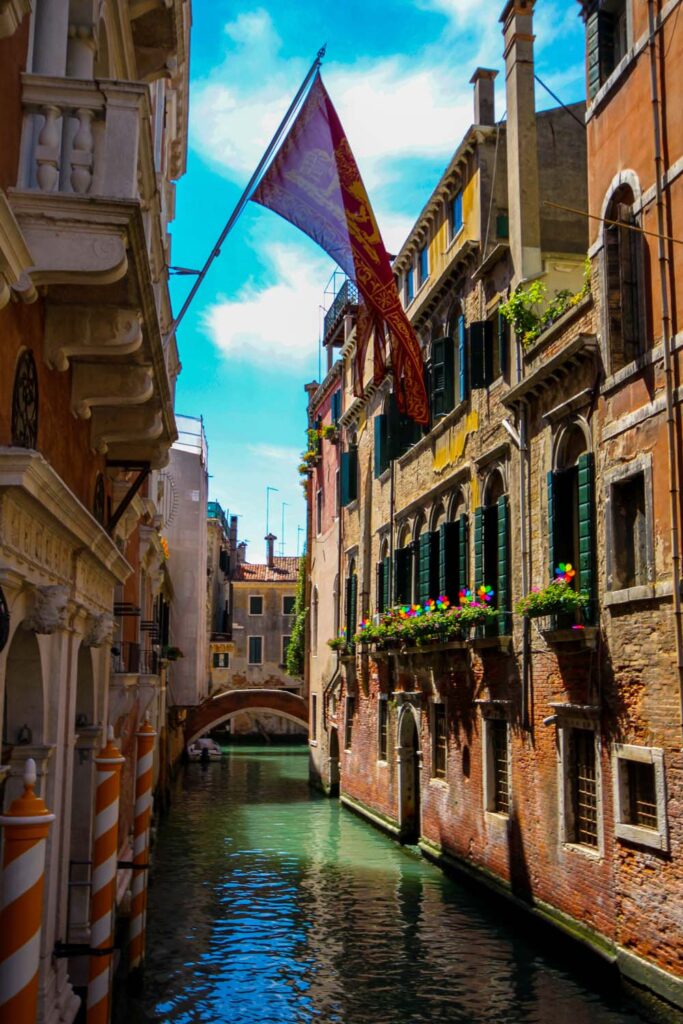
The Grand Canal
Continue walking north along the Corte Theatro, through one of the darkest brick tunnels, until you emerge out into the bright light of the Grand Canal. As this is the first time we are really faced with the view of the Grand Canal, I suppose we should talk a little bit about this ever so important waterway. The Grand Canal essentially splits the city of Venice into two. While the original waterway which ran through here was no doubt much narrower, the ancient river is thought to be a branch of the Brenta. Ancient Venetian fishermen were once the only ones who lived here, in simple stilt houses.
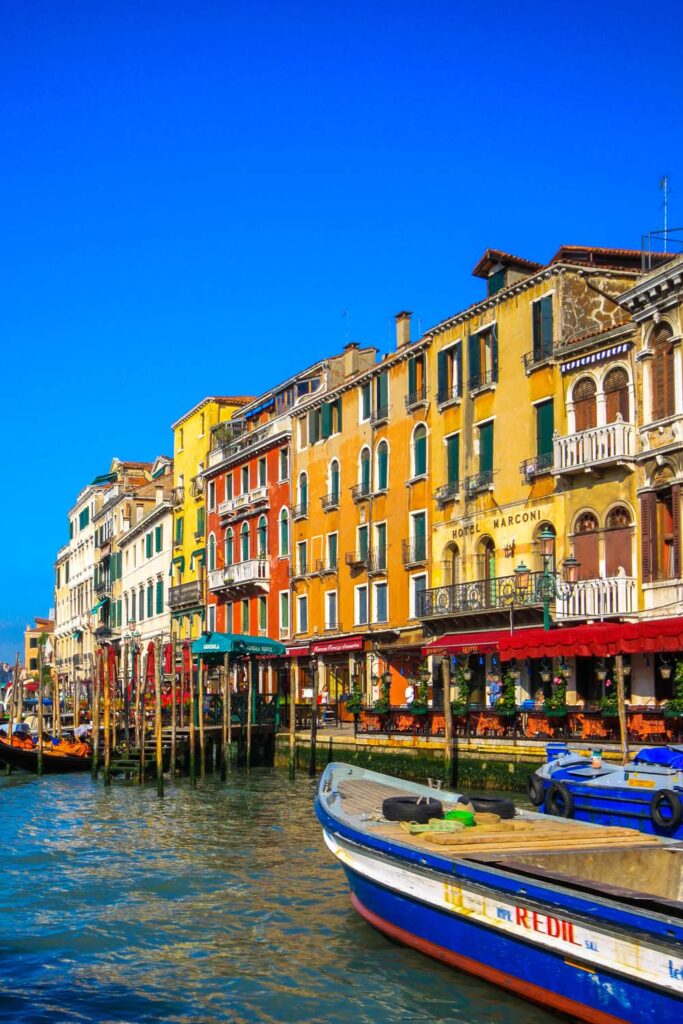
It wasn’t until the 9th century when the Doge moved his palace into the more protected area of what would become St Mark’s square, that the canal was widened. The canal needed to be larger in order to make room for the large ships needed for the construction of the palace. The canal became less of a fishing spot and more like a ritzy main street. Wealthy families began buying up property and building their huge manors along the Grand Canal.
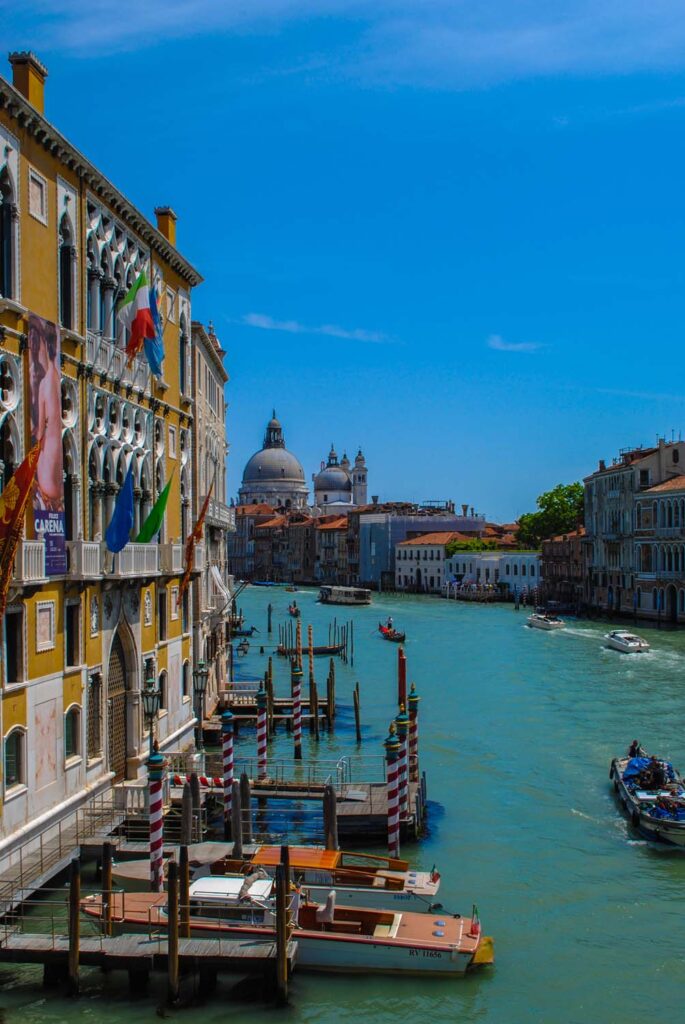
History of the Grand Canal
The grand canal was the entryway into the city and the Venetian Republic wanted every building lining it to demonstrate the city’s power, wealth and artistic sensibilities. Like a parade of the best architecture Europe had to offer. This huge canal is now flanked by 170 illustrious buildings, which are from as early as the 13th century to the 18th century.
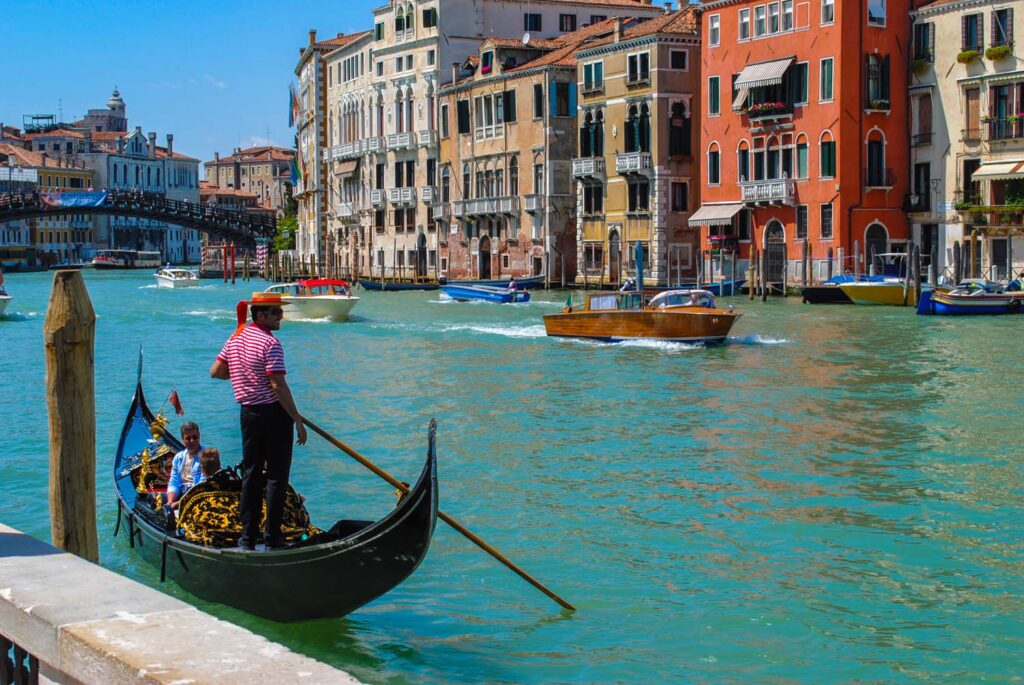
Rialto Bridge
Continue along with the Riva del Ferro, walking along the edge of the Grand Canal. Emerging from the last arcade you’ll be greeted almost immediately by the sight of the bright white stone of the Rialto bridge. The Rialto Bridge is the most famous of all of Venice’s canal bridges. It is also the oldest of the four major bridges which connect the various districts of Venice. The original wooden bridge installed here was built here in 1173. Back then it went by the name Ponte Della Moneta, which means “money bridge“. The reason for this was that on one side of the canal once stood the largest mint in Venice. People would flood into their area and across the bridge at all hours of the day to deposit and take out their cash!
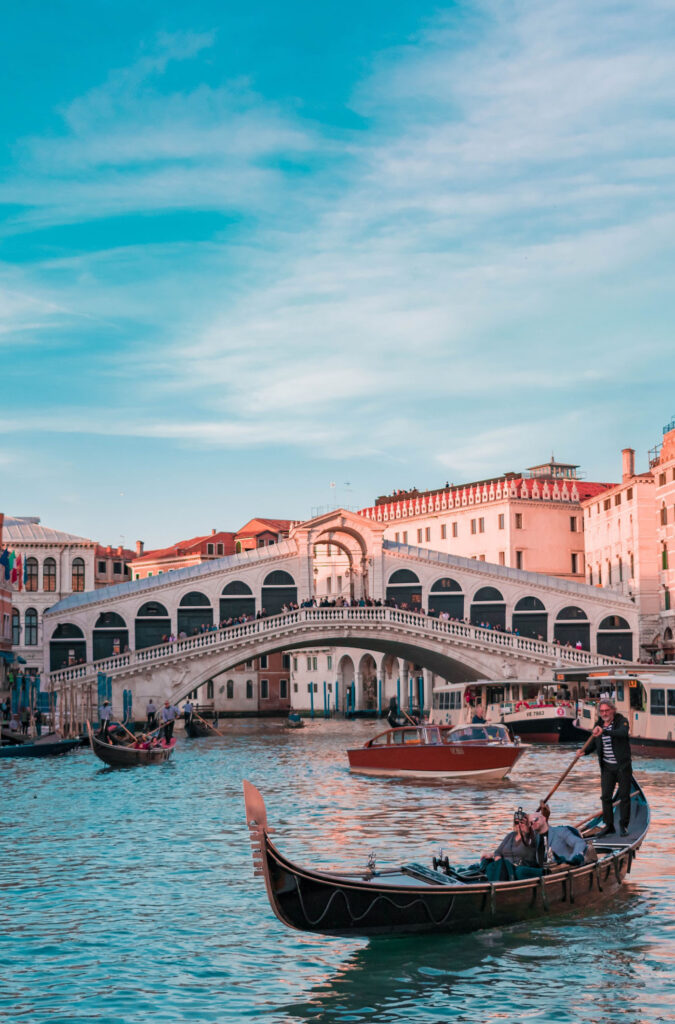
The old wooden bridge was split down the center and could be raised on either side, to allow for tall ships to enter into these narrow canals. This was of the utmost importance especially when the Rialto Market opened, as boats would come in in mass to deliver fresh fruits, vegetables and fish. But as time past, the wooden bridge just wasn’t up to snuff though. After years and years of wear, riots, fires and crowds eventually it collapsed.
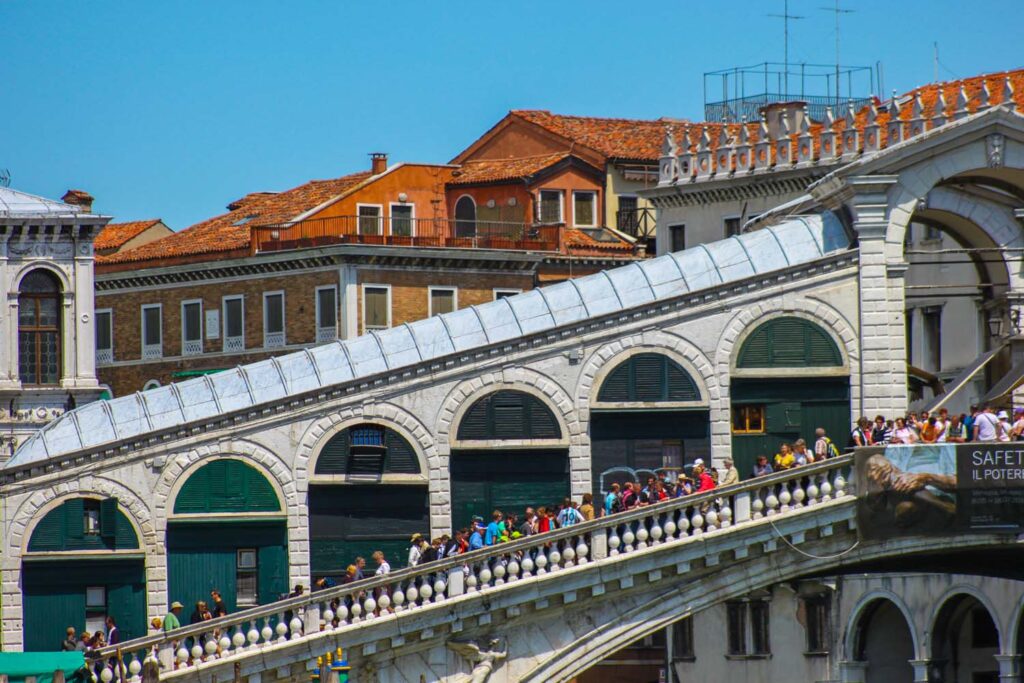
New Rialto Bridge
The new Rialto bridge design was completed in 1551. The architect who designed it did away with the raised wooden design and instead favoured stone as it was more durable and could last the test of time. Since the stone bridge couldn’t be raised, he needed to ensure that the two inclined ramps would be tall enough to accommodate the galley ships that needed to pass through. The result is this grand archway which looks like a gilded enclosure around a picturesque living portrait. The stone structure also featured a covered portico on top with rows of shops on either side. The addition of shops here meant that their rent could help pay for the maintenance of the bridge going forward. Between the inclined set of porticos is a large arch, like the crown atop this stunning structure.
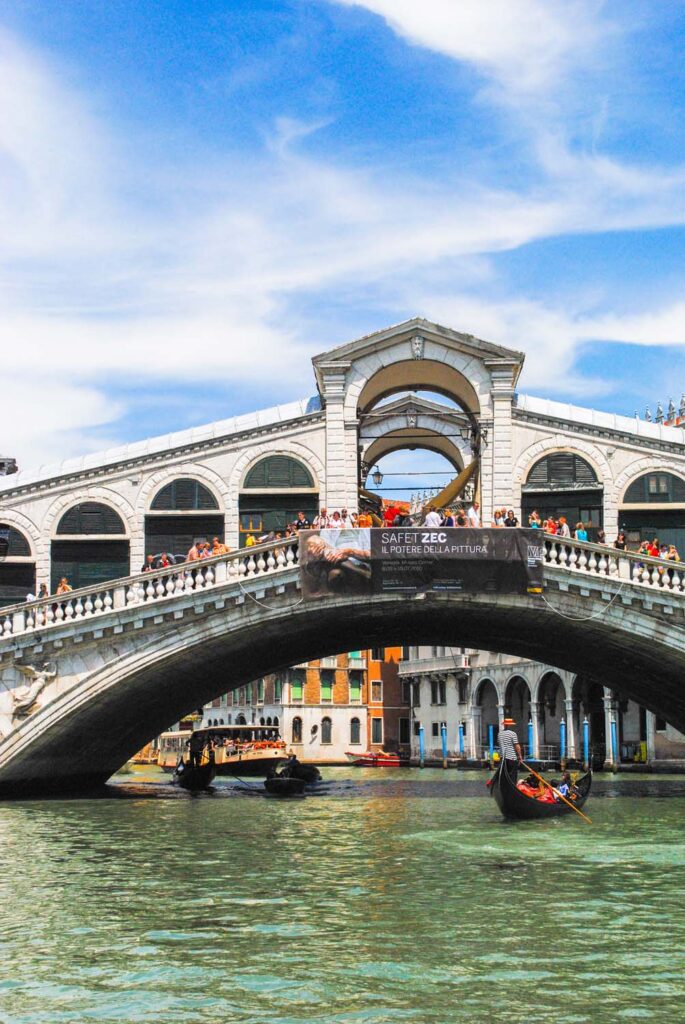
While the bridge has become somewhat of a tourist trap, with stores selling souvenirs lining the entire walkway, early in the morning when they are all closed, this bridge still keeps its magic. There are these two little nooks on the bottom of the bridge, where you can sit right under it, besides the water. This is one of the most amazing places to watch boats and gondolas float by with stacks of fruits and vegetables coming into the market as dawn casts itself on the city. The top of the bridge is also one of the most iconic spots for pictures in Venice.
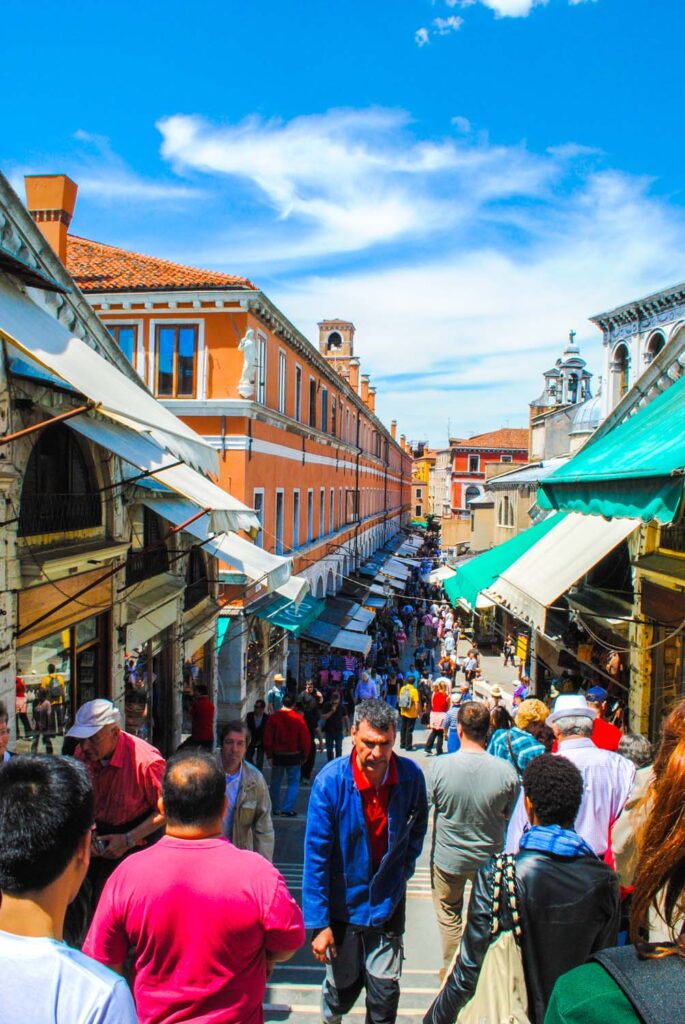
Mercado di Rialto
Now that you’ve been introduced to the look of the city, it’s time to meet the people of Venice. And there is no better place to get a peek into the real lives of the residence of Venice than to head to the Rialto Market! The Rialto Market is one of the last remaining fresh food markets in the city and as such, is a bustling place for locals to come and buy their food for the day. The outdoor portion of the market is where you’ll find seasonal fruits and vegetables. If you’re looking for a snack there is nothing more refreshing than a basket of freshly picked fruits!
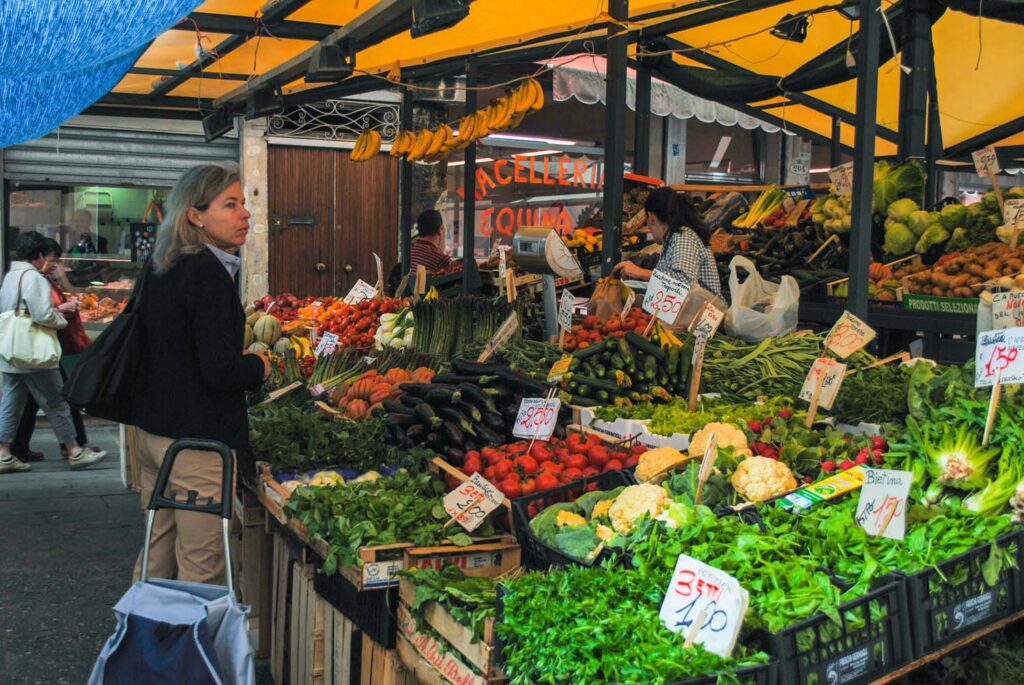
But the Rialto Market is much more than just a place to get some of the best food in the city! It is also a place of great historical value. Of all the rich bankers and traders who lived in the region, the most famous were the Rivoalto family. The Rivoalto traders were one of the first families to come into the lagoon to set up a trading post. They picked this location because it was situated along the bend of the lagoon. This meant it was located on higher ground and therefore was spared from some of the floodings that other parts of the island experienced. The first known market took place here in 1097. Because the family didn’t have to constantly rebuild themselves, the Rivoaltos grew in prominence and wealth over time, eventually having the very spot named after them.
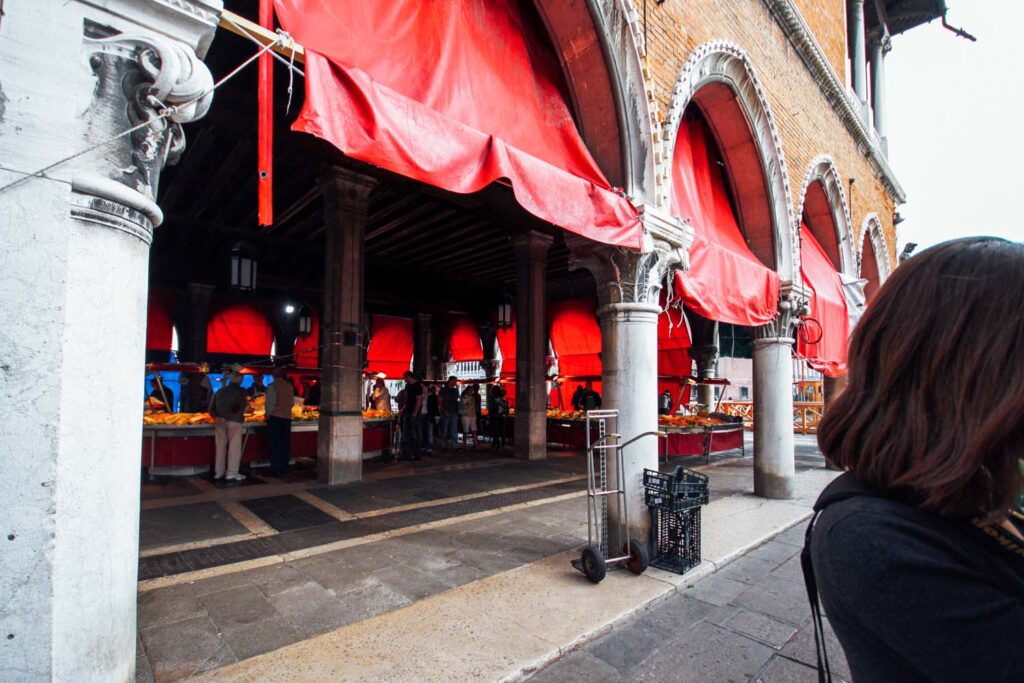
Pescheria
Opposite the green awning of the outdoor market is the neo-gothic fish hall, or Pescheria, built in the early 1900s. Outside the red brick building there is still to this day a marble plaque which you should study before heading inside. This plaque denotes the different types of fish which were allowed to be legally sold here when the marketplace was first built. Certain fishes were protected from overfishing and therefore there was a limit to the amount any one person could buy.
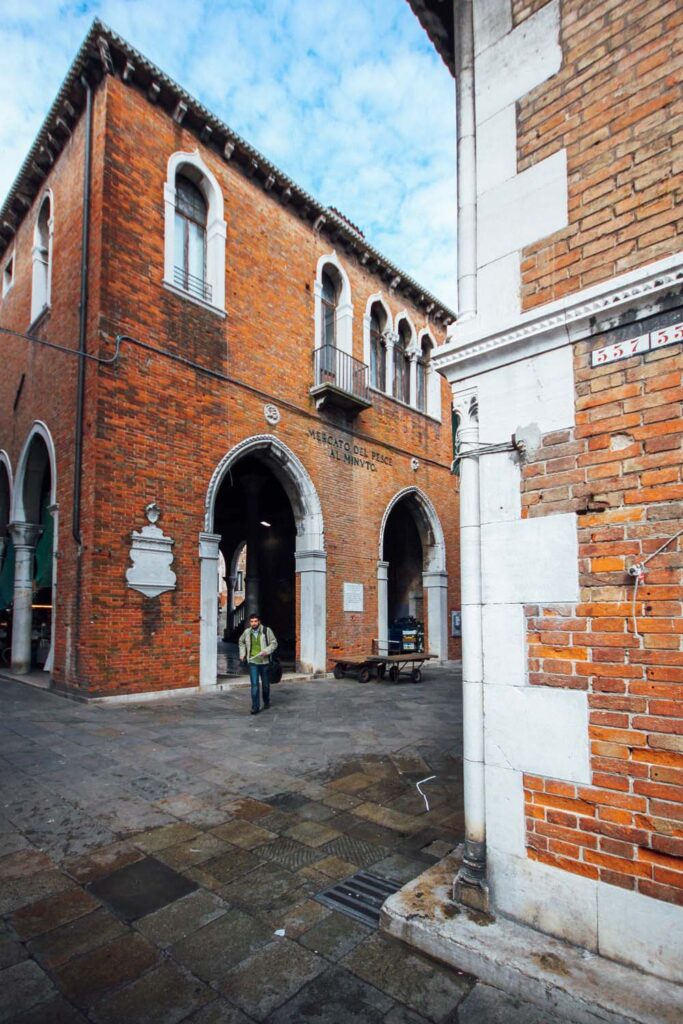
The fish hall is a soaring building with richly ornamented arches surrounding the exterior. Inside the columns continue throughout the interior, making a simple stone building feel rich and illustrious. Fresh fish has long been one of the most important resources in Venice. Right outside their door, this amazing product is caught daily. It can’t get much more local than that!
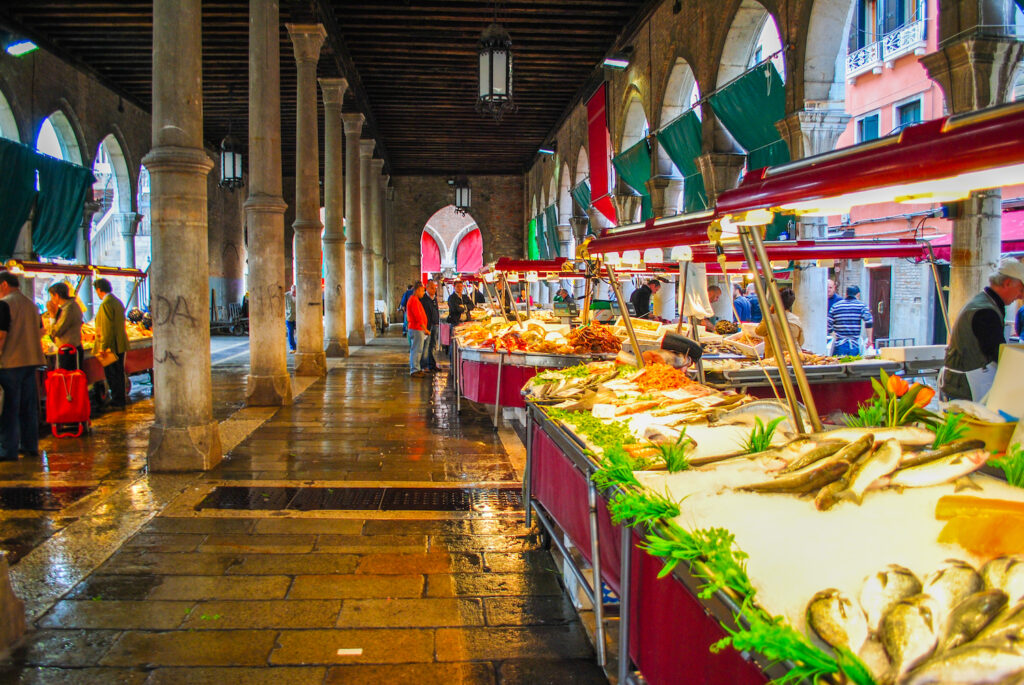
Buying food at the Market
The market place was facing the chance of being shut down a few years ago, due to a possible canal expansion for cruise ships. Thankfully the citizens were able to convince the city to stop this and the market was saved. But as more and more people choose to shop at larger grocery stores off the island markets like this always face the chance of being closed. So if you’re going to visit, be sure you buy at least a little something. We bought some fresh raspberries and cherries and they were absolutely delicious!
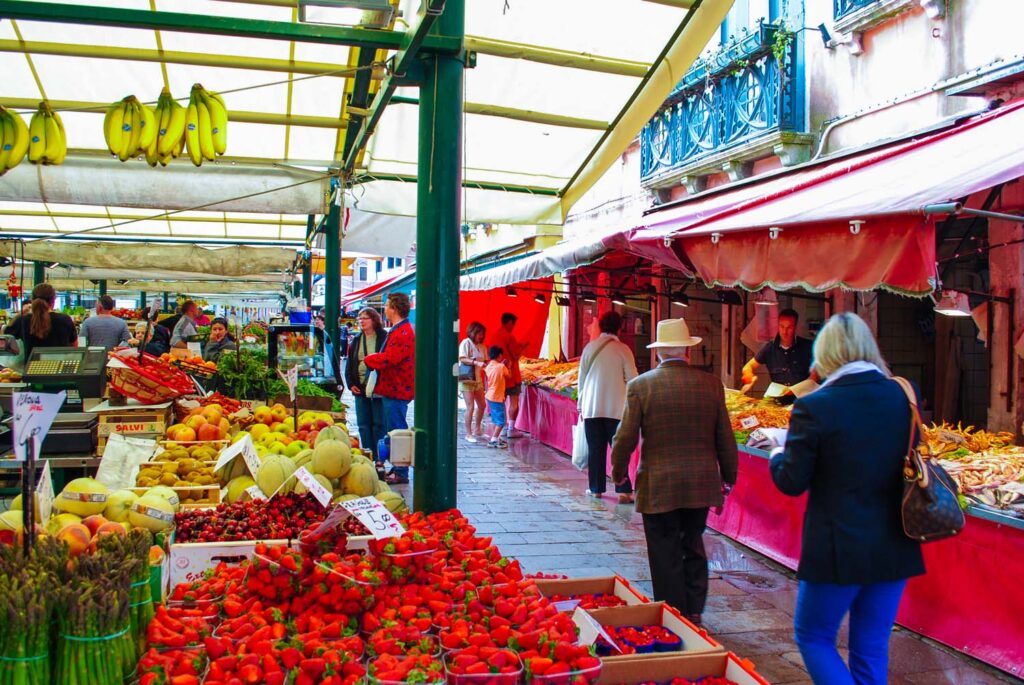
Basilica dei Frari
But probably what brings most people to San Polo is the Basilica dei Frari or Santa Maria Gloriosa dei Frari. But most people just call it the “Frari” for short. The church is the beating heart of this neighbourhood. In 1231 the Doge Jacopo Tiepolo donated some land to the Franciscans. The original church he had built was small and as the Franscians rose to power, they demolished it in exchange for a larger, more impressive design. The current version was built in the 14th-century in high Venetian Gothic style.
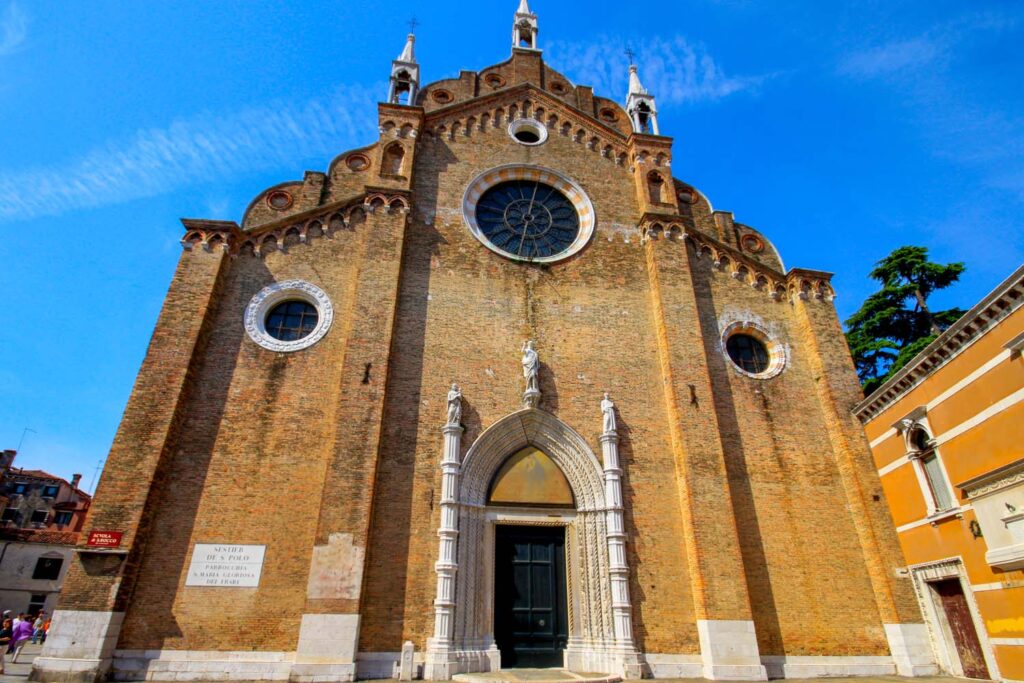
At the back of the church is the great campanile, which is the second tallest tower in the city, after San Marco’s tower. The bell tower was built in 1396 and still stands today! The unassuming facade might fool you into thinking at first blush this church isn’t very important. But in actuality, it is perhaps one of the most significant churches in the city.
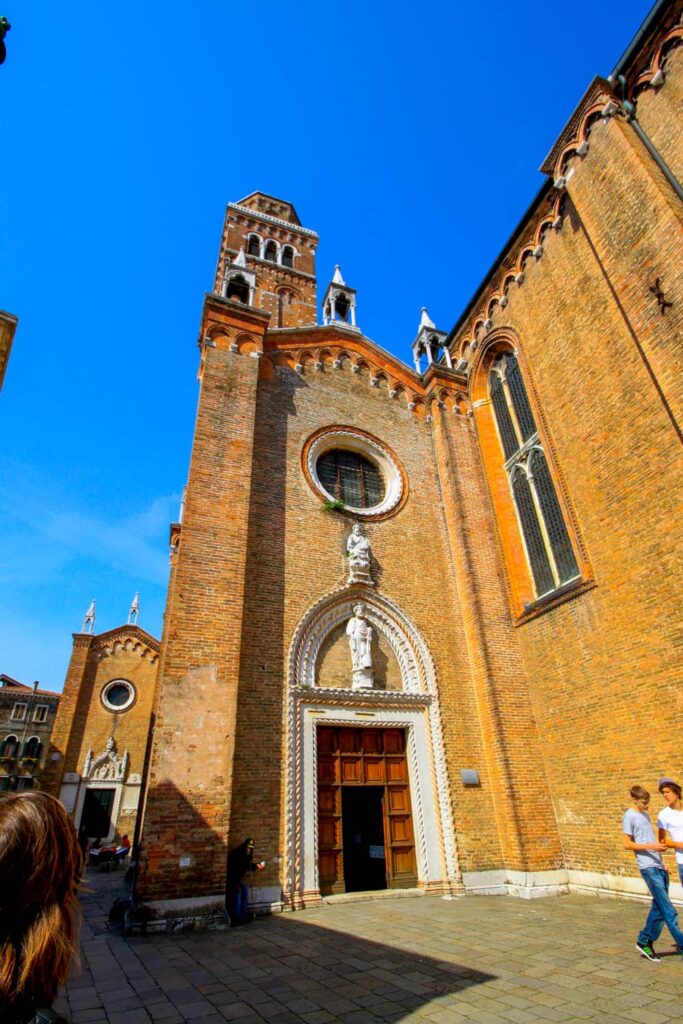
Titian Paintings in Venice
Many Doges were buried here under the watchful eye of masterful works of art by the painter Titian. Titian, who was a Venetian himself, painted the great altarpiece inside the church. The Assumption of the Virgin by Titian is one of the first things your eye is drawn towards as you enter the church. It sits behind the high altar, lit by the glow of the stained glass windows behind it. This piece is perhaps the best example of Titan’s masterful work. Setting the standard for Venetian art during the Renaissance.
Entry into the Church
There is a small fee to enter the church (€ 3,00) but it is more than worth it to gaze upon the painting the Assumption of the Virgin in situ. When I first saw this painting in person, it was a moment of awe for me. Some paintings, like the Mona Lisa perhaps, don’t live up to the hype. But this one is even more grandiose and firey in person than it was on any page or screen.
Titian died of the plague at the age of 94 and a memorial to his life and death stands inside the great basilica. The monument is gigantic! A version of the Assumption painting is carved into the stone behind an image of the painter crowed with a laurel wreath. On either side of the artist are two figures which represent the universal nature and the genius of knowledge. The other four figures are Painting, Sculpture, Graphic Art and Architecture.
Dorsoduro District
The Dorsoduro district is located on the bottom of the Venetian islands. This area borders the Grand Canal as well as the Venetian Lagoon, making it a prime spot for traders to live. While it’s not as flashy as the other districts, think of this as the blue-collar neighbourhood, I still find it to be one of the most charming areas in Venice. Dorsoduro lacks the pretensions of the other neighbourhood. Since it’s home to Venice’s Ca’ Foscari University you’ll also find the new blood of Venetian society, its students, who liven up the streets with modern music, food and entertainment.
Ponte dei Pugni
Continuing south, we’ll be going to pass over the Ponte dei Pugni. I love the view from this bridge. If you look towards the west you can see the bell tower from the church of Santa Maria del Carmelo. On either side of the bridge are a pair of footsteps marked on the corner. This marked the beginning of where the great fight between Venice’s two rival family factions took place in 1705. Thereafter, many more fights took place here. Opponents would stand on either side of the bridge, where the footsteps are now marked. Originally, there were no railings on this bridge, so when the two opponents would fight, the first one to fall off the bridge and into the water as the loser.
Cantine del Vino già Schiavi
By this time, we are approaching the evening, but its not time for dinner just yet. Oh no, first we must have aperitif! And one of the best places to get it in Dorsoduro is Cantine del Vino già Schiavi. This bar sells Cicchetti (small snacks) which include Venetian classics like crostini topped with salt cod and wild garlic, pistachio cream or alioli with flower petals. Grab an Aperol spritz to drink while standing at the bar to feel very much like a local.
Calle Nuova Sant’Agnese
Head northeast until you reach the Calle Nuova Sant’Agnese. This narrow street is filled with shops. Being so far away from the touristy areas, these stores are known to seel authentic Venetian goods but at reasonable prices. In addition to the tourist shops, you’ll also find unique boutiques which are a great way to support local businesses.
Basilica di Santa Maria Della Salute
If you’re still feeling up for it, continue walking through Dorsoduro, eastwards, until you reach the Basilica di Santa Maria Della Salute. This stunning white marble church is not only a sight to see, but where you can get a great view of Saint Mark’s square, where we first started the tour.
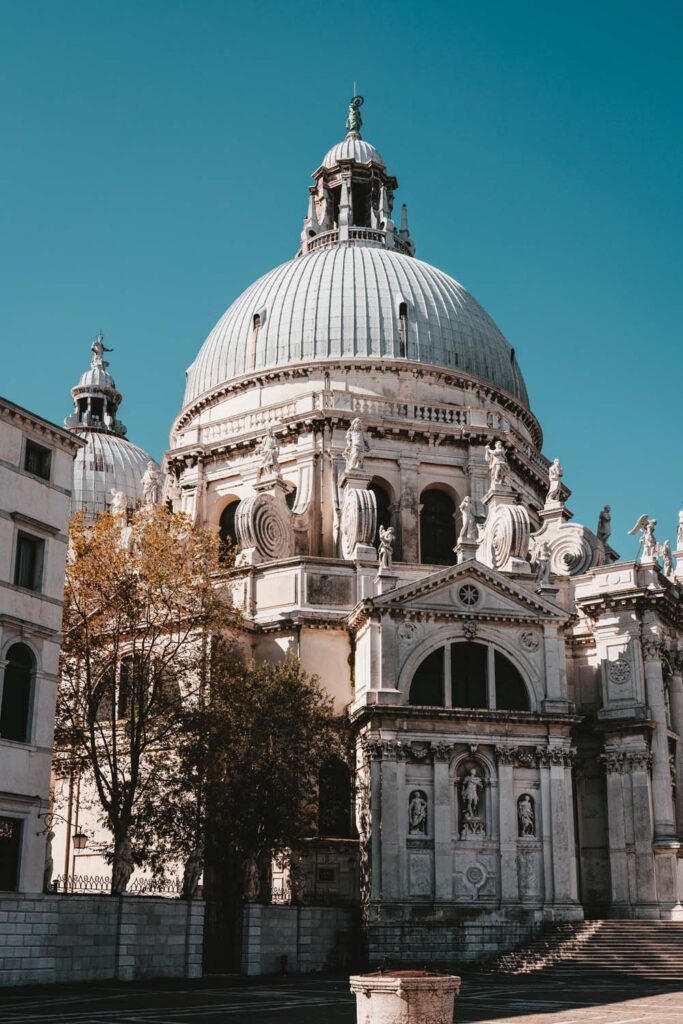
In 1630 Venice was being ravaged by the plague and there was no signs of it stopping. At the time, one of the ways people thought you could stop the plague was by making an offering to god and pray he would send deliverance to the city. So, the Republic of Venice built the church to Our Lady of Health as a last resort. Eventually, the plague period past and the city was able to start rebuilding itself. Nearly a third of the population of Venice died during the plague. Those that survived would remember that harrowing experience forever. Since the church was made in honour of stopping the plague, most of the art and symbolism you’ll find throughout the church in some way refers to death or the plague, making it a very uniquely themed church.
The Dome of Basilica di Santa Maria Della Salute
The church is most notable for its humongous white dome which dominates the sky. The dome, which almost seems to defy gravity, became a symbol of inspiration for artists in the city. To support the huge dome and enormous marble church, 1,000,000 wooden piles were used to hold up the floating building. At the apex of the central pediment stands a statue of the Virgin Mary, looking out of the city. The group of figures in the scene is stunningly theatrical and it really looks like a moment frozen in time.
If you choose to come inside be sure to check out the statuary group at the high altar. This stone scene depicts depicting The Queen of Heaven expelling the Plague and was crafted in 1670.
Zattere
To finish the evening, walk down south towards the far end of the island. The stone promenade which flanks the water’s edge is called the Zattere. Zattere in Italian means rafts. In the 16th century timber would arrive in the city on large rafts. Timber was not only used to constructed the walls of grand palazzos and houses in Venice, it was literally the ground on which the houses were built on. So timber was one of the most important imports in the city. Timber was also used to make gondolas up until the 18th century. Suffice to say, the city was literally built around the timber industry and therefore its importance is not to be ignored. The earliest parts of the Zattere date as far back as 1520! Today the wide promenade is a great place to watch the sunset against the waters of the canals.
Trattoria San Basilio
If you’re feeling like you would like to dine somewhere close to your accommodation there are Vaporetto stops all along the Fondamenta Zattere. But if you’re looking for something special along the water’s edge, but away from the touristy hub, you should check out Trattoria San Basilio.
This down to earth restaurant is located inside the corner of one of the older buildings in the Zattere. It barely looks like a restaurant at all except for the awning and few tables and chairs out front. But don’t let its modesty fool you, here you’ll find a relaxing atmosphere, friendly staff, and best of all, traditional Venetian cuisine. Their seafood spaghetti with mussels, clams and squids, tastes so fresh you’d swear the food jumped right onto your plate straight from the water. Try to get a spot outside to enjoy the sunset or the boats as they drive past into the moonlight.
Phew, well that brings us to the end of this tour! Hopefully, if you packed this all into one day you found things along the way to return to tomorrow to investigate further! Let me know which neighbourhood was your favourite or what you’re most looking forward to visiting!
Happy Travels Adventurers!
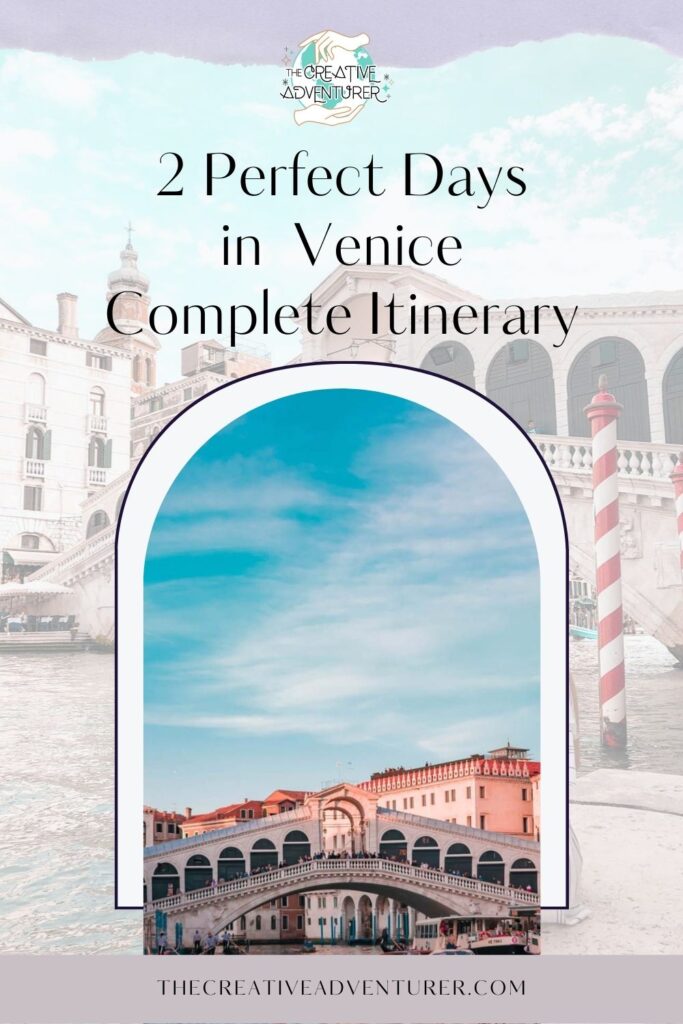
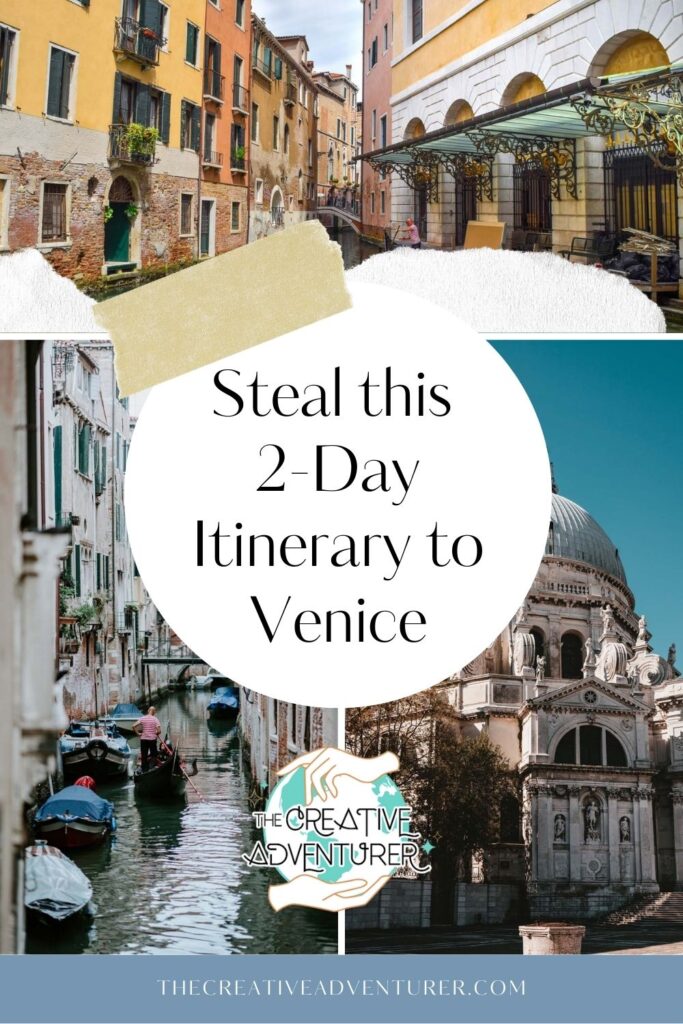
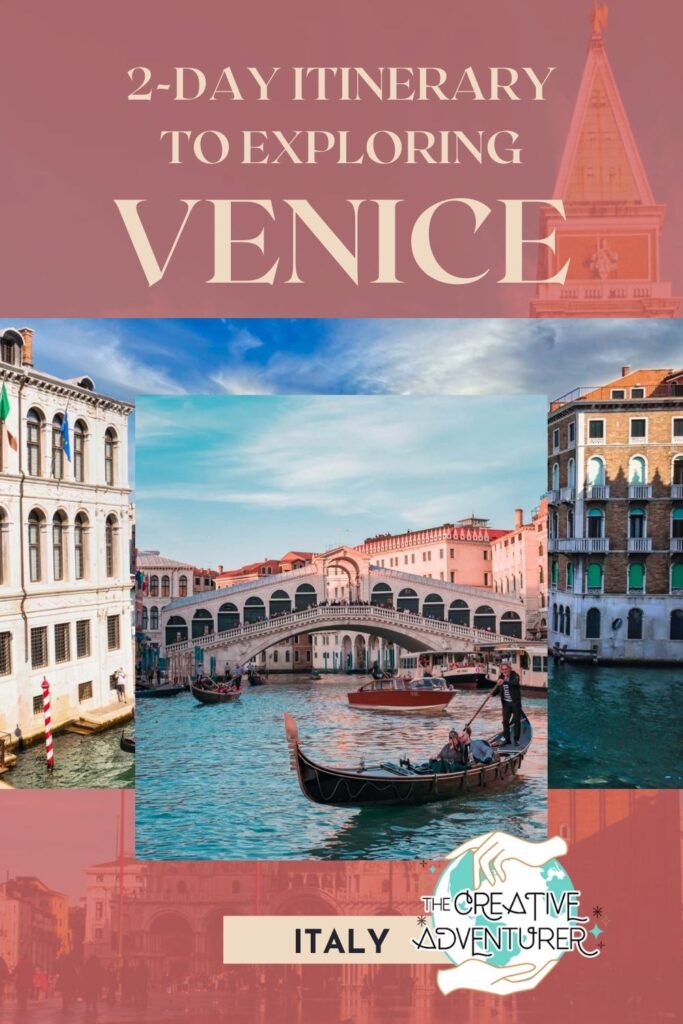
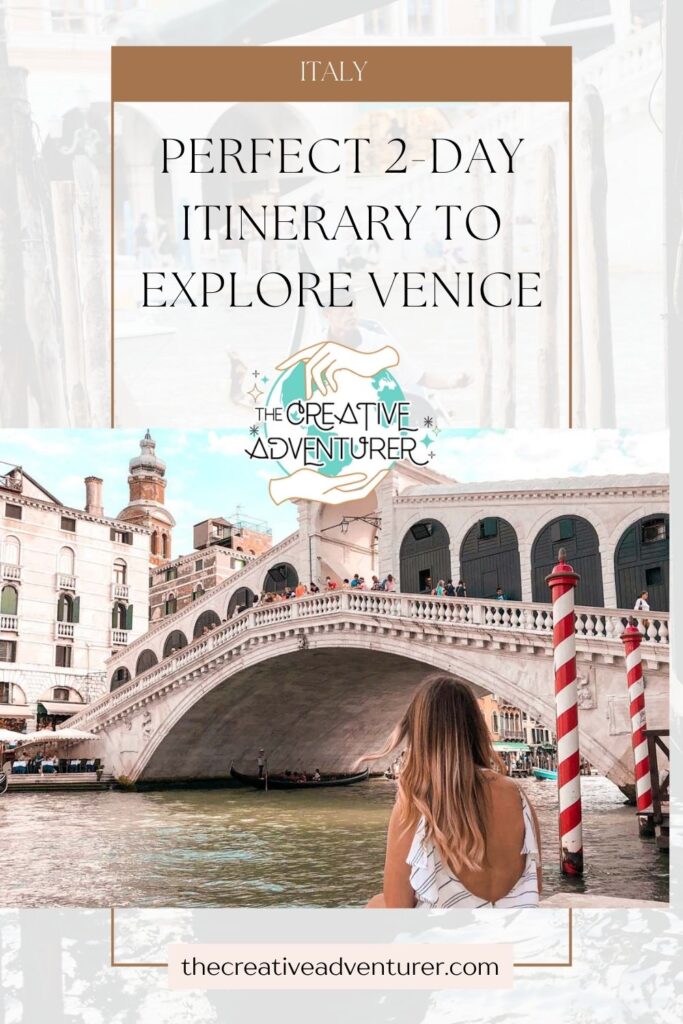
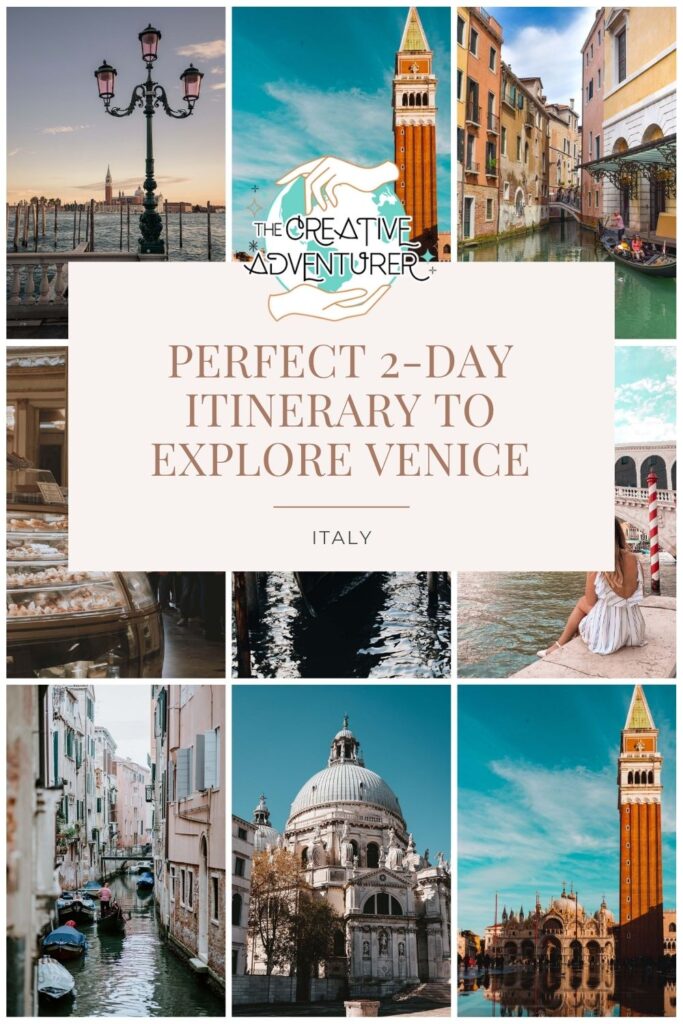
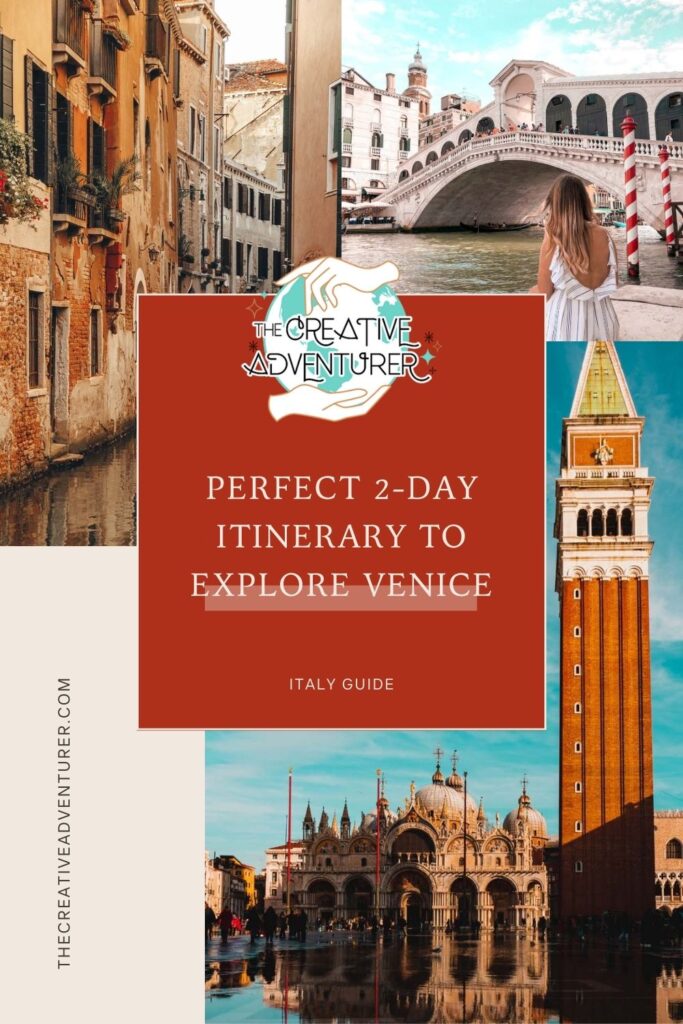
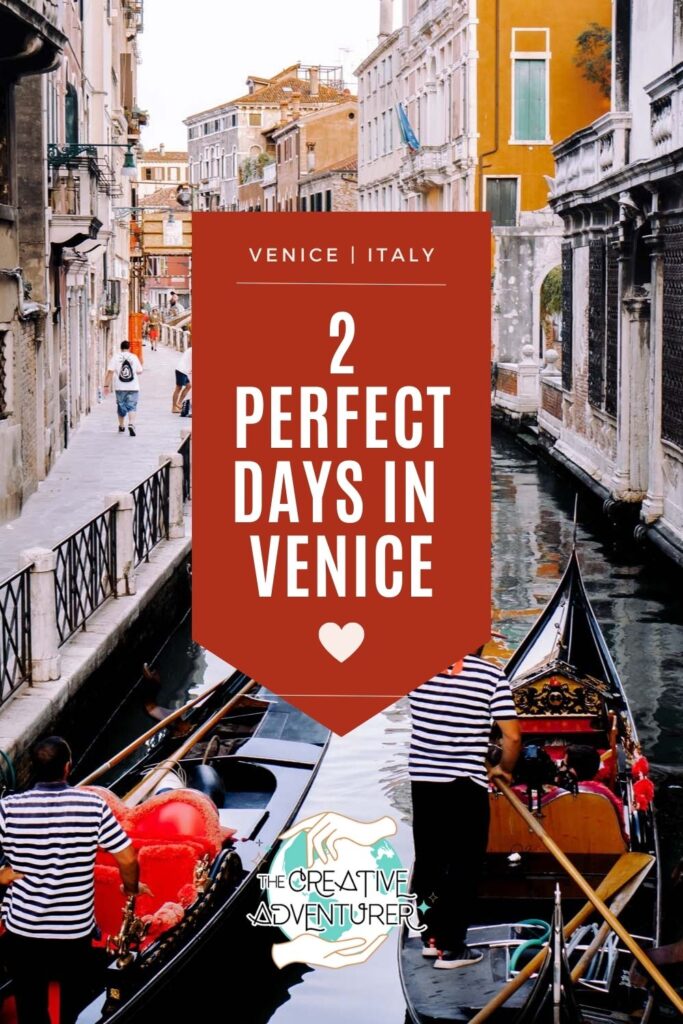
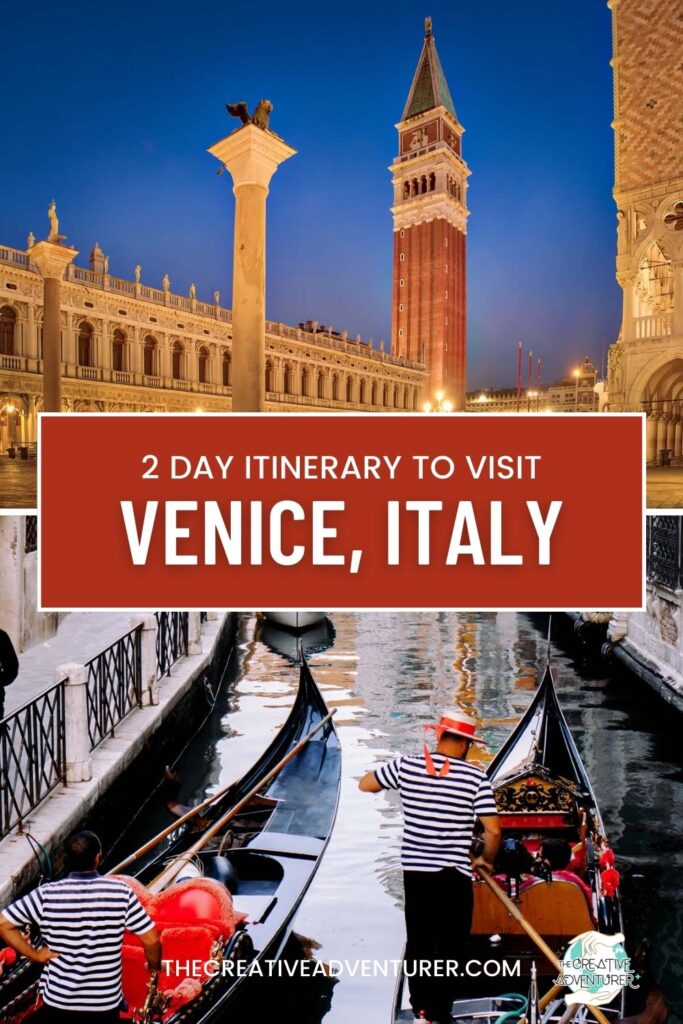


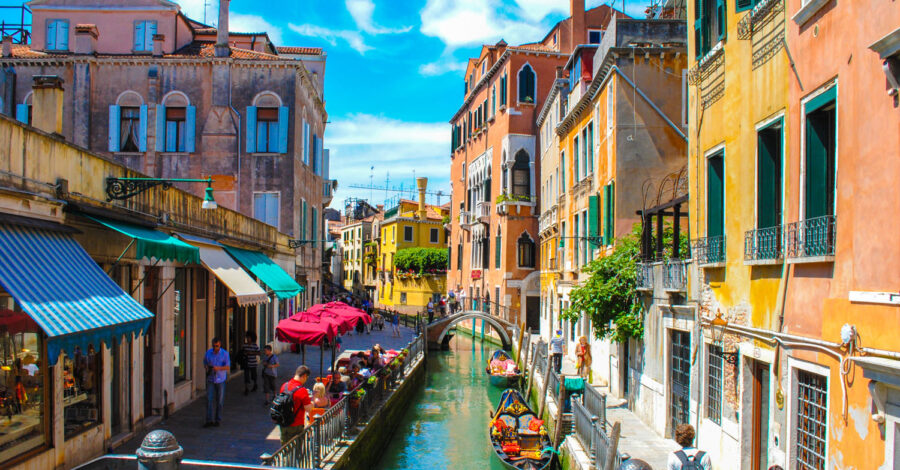
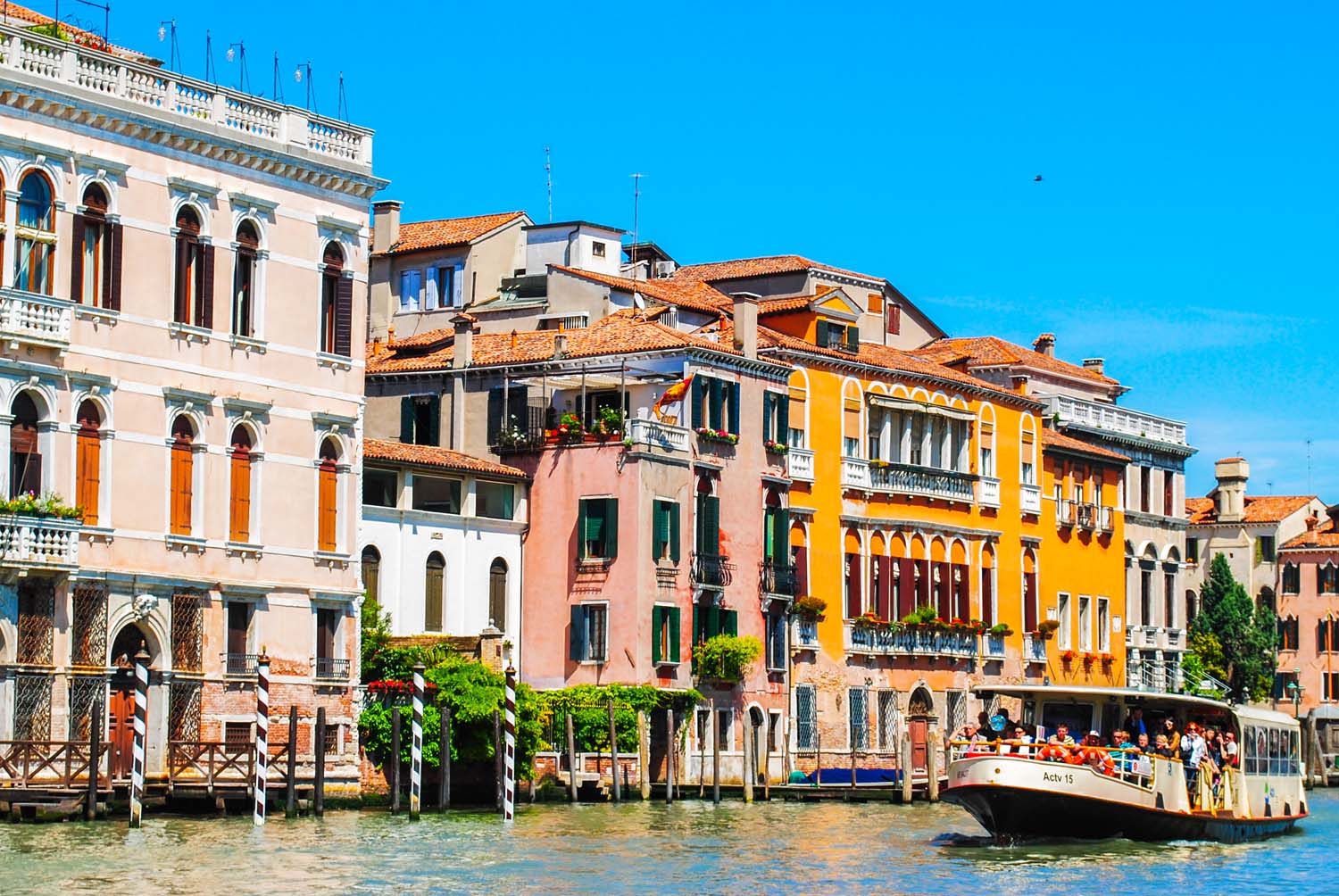
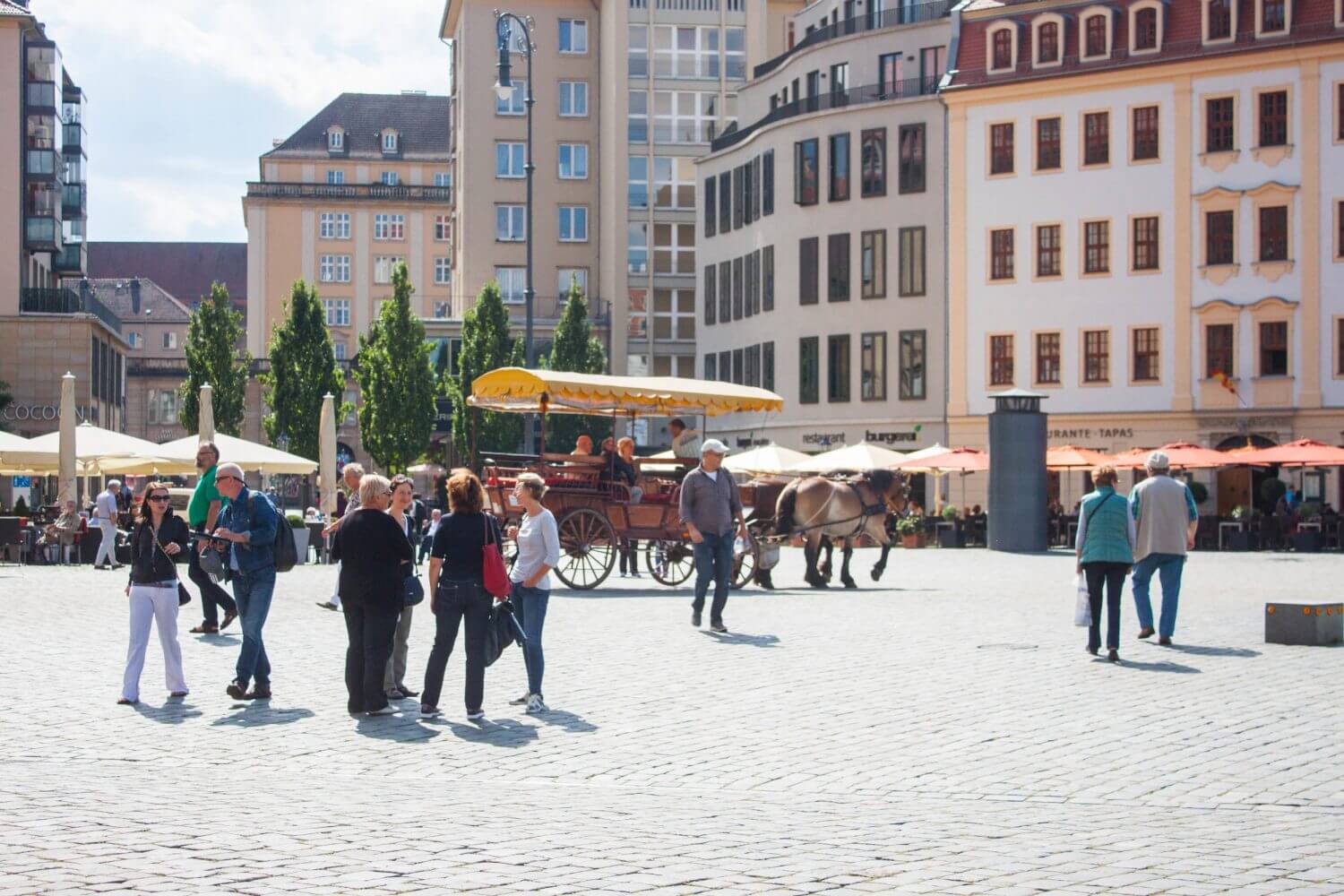
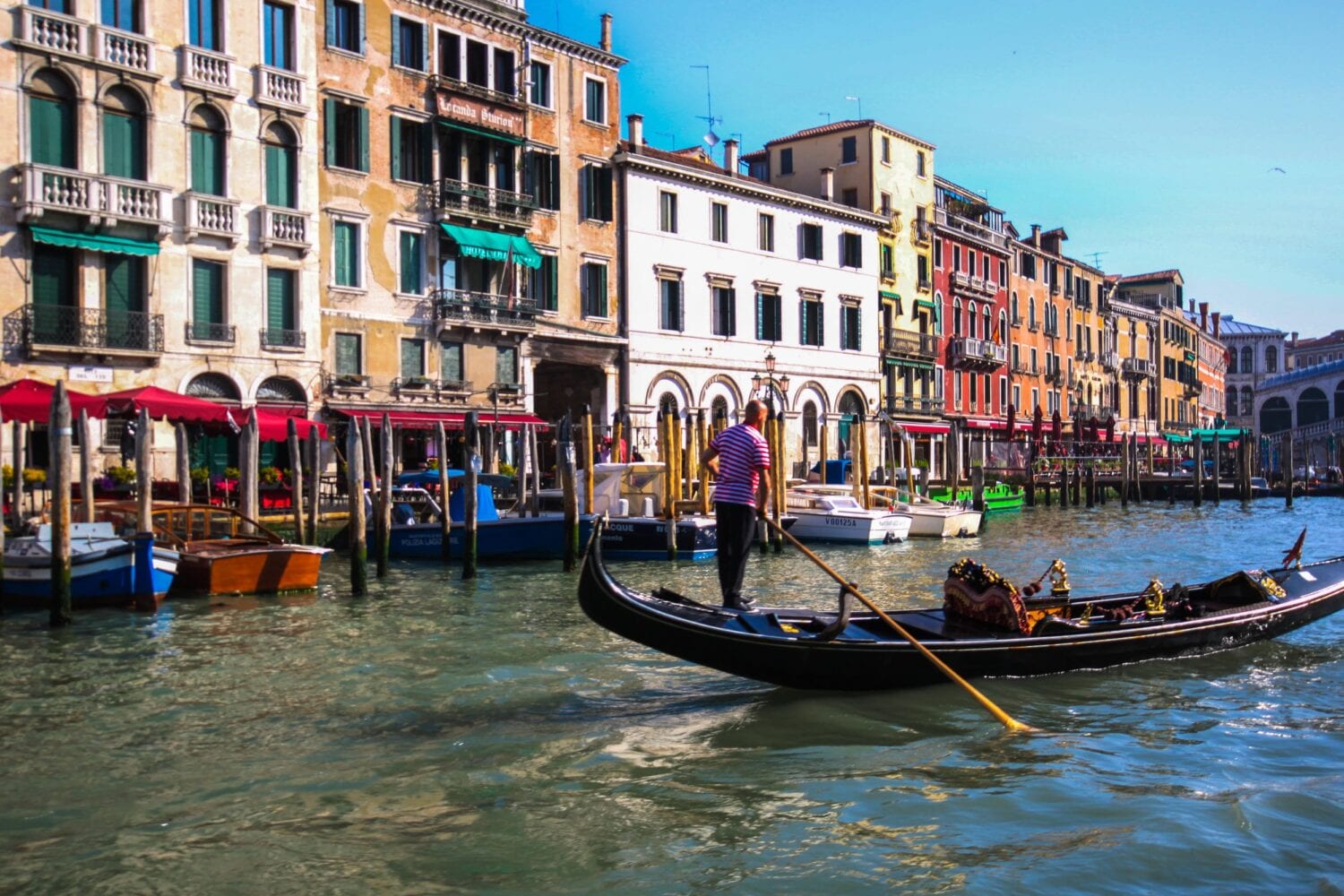
2 COMMENTS
Martha Kaufman
1 year agohow do I acquire the walking tour of Venice so that I can print it out before I arrive?
The Creative Adventurer
1 year ago AUTHORHi Martha, You can purchase the walking tour here > https://thecreativeadventurer.com/product/self-guided-walking-tour-of-venice-downloadable-pdf/ And you can save it onto your phone, or iPad.